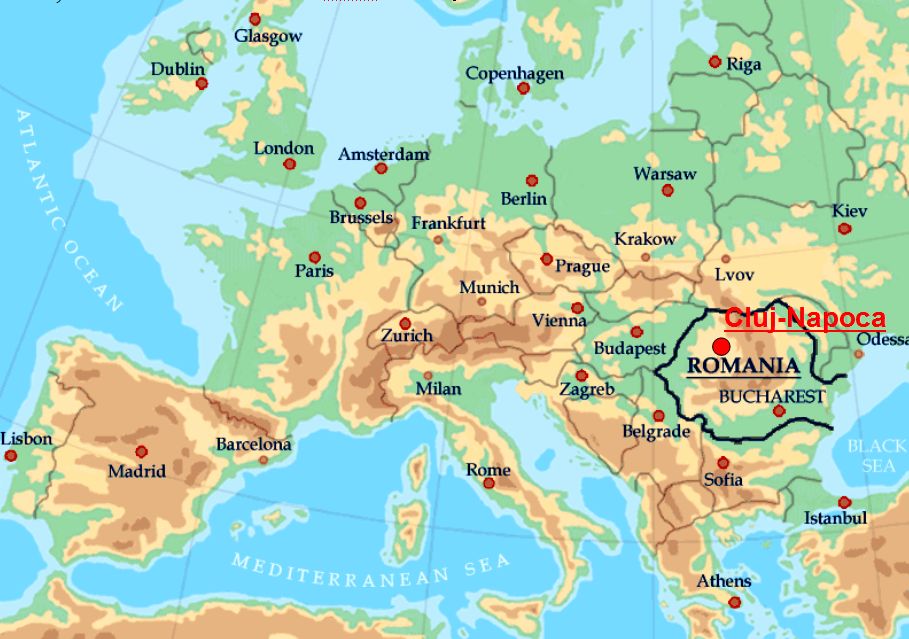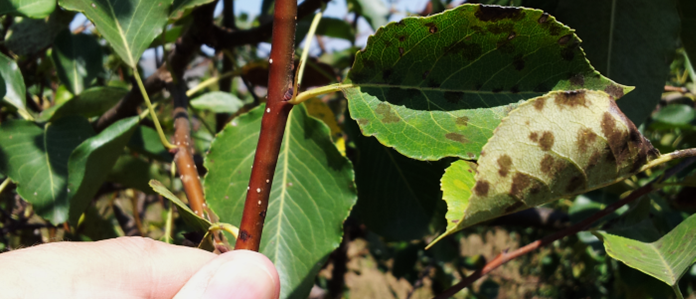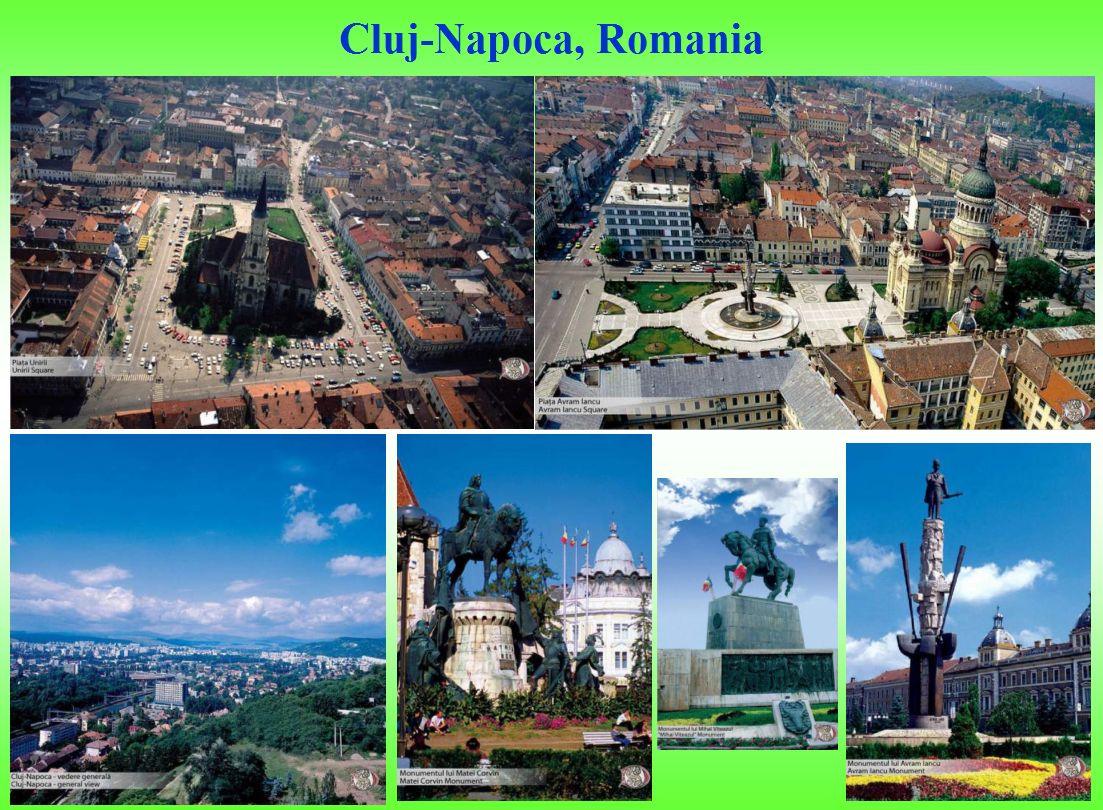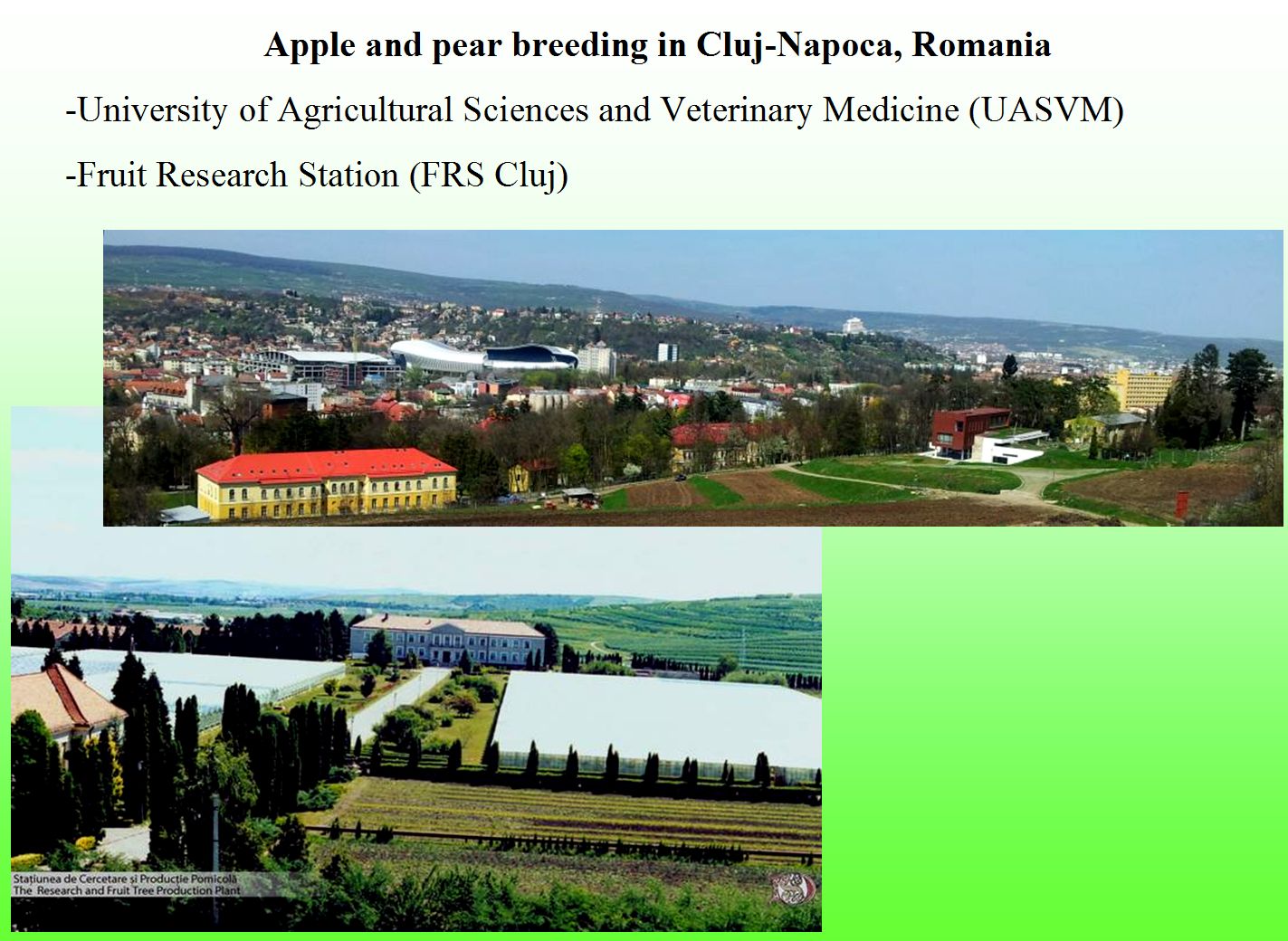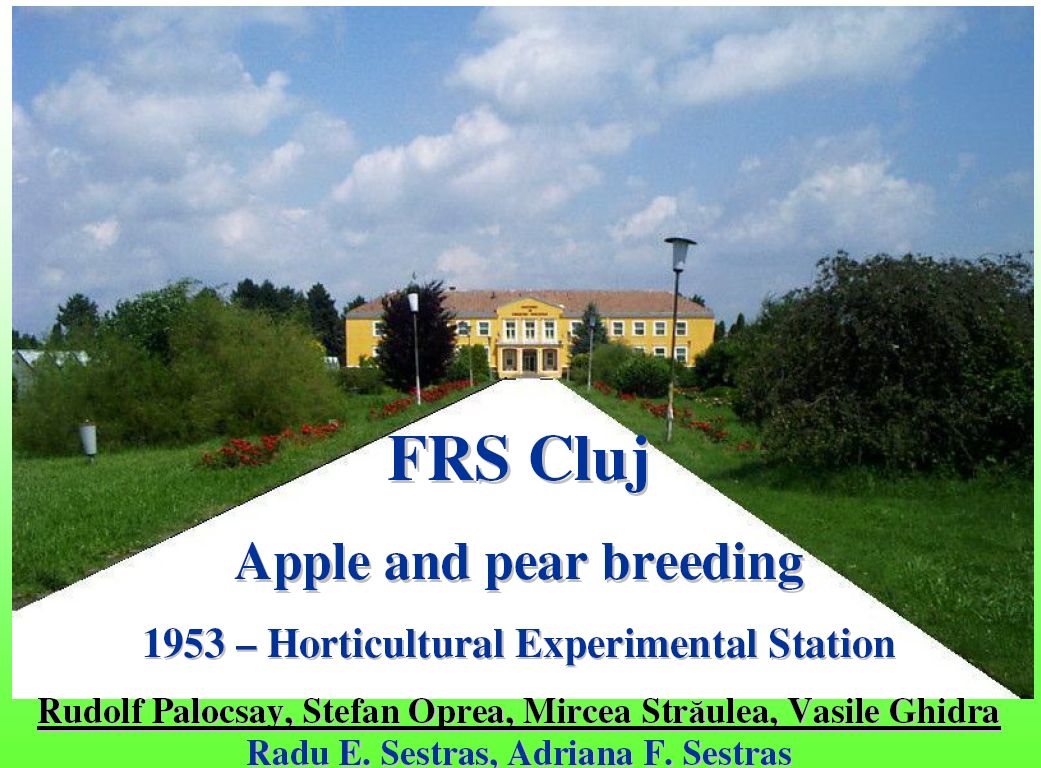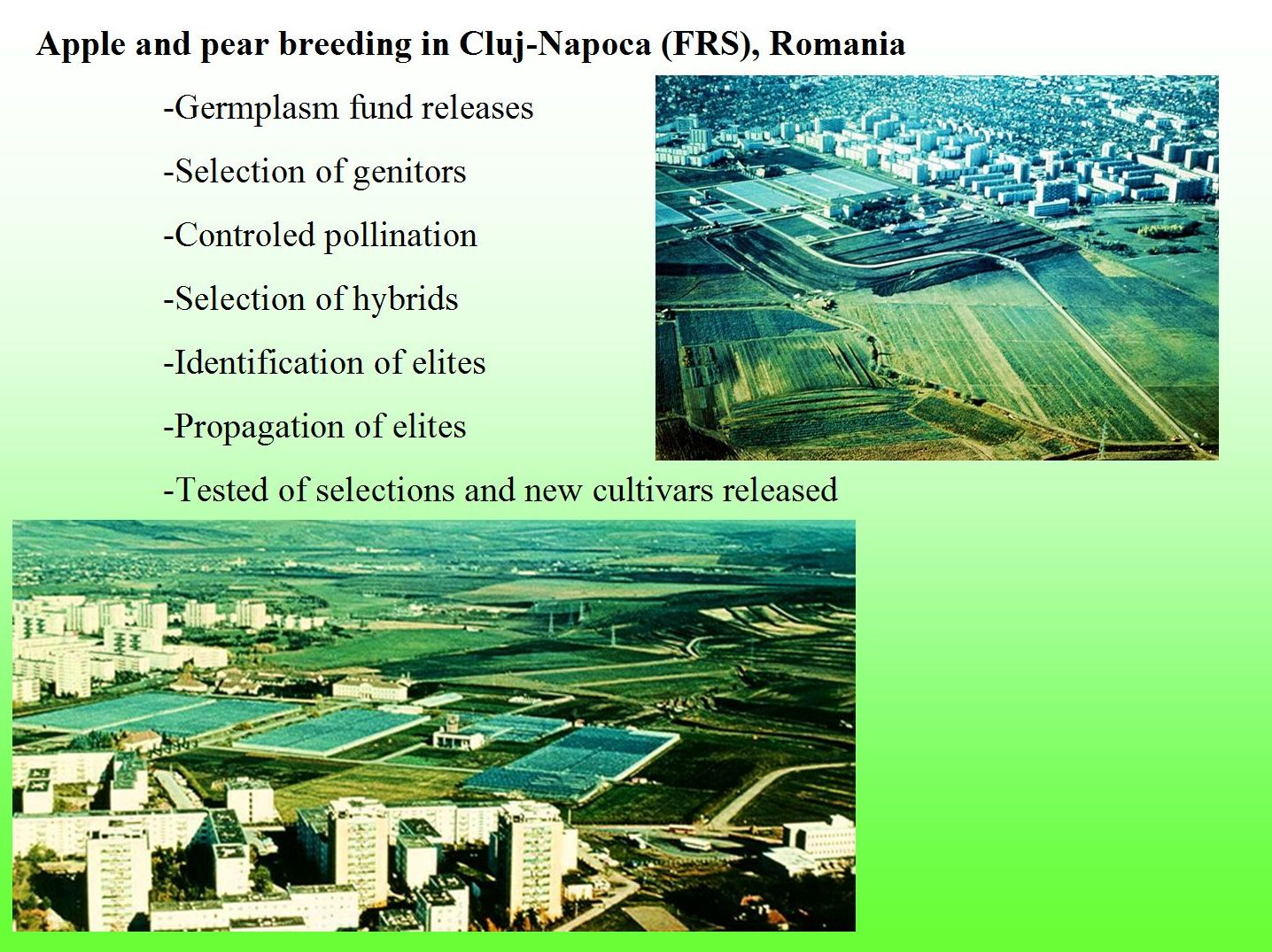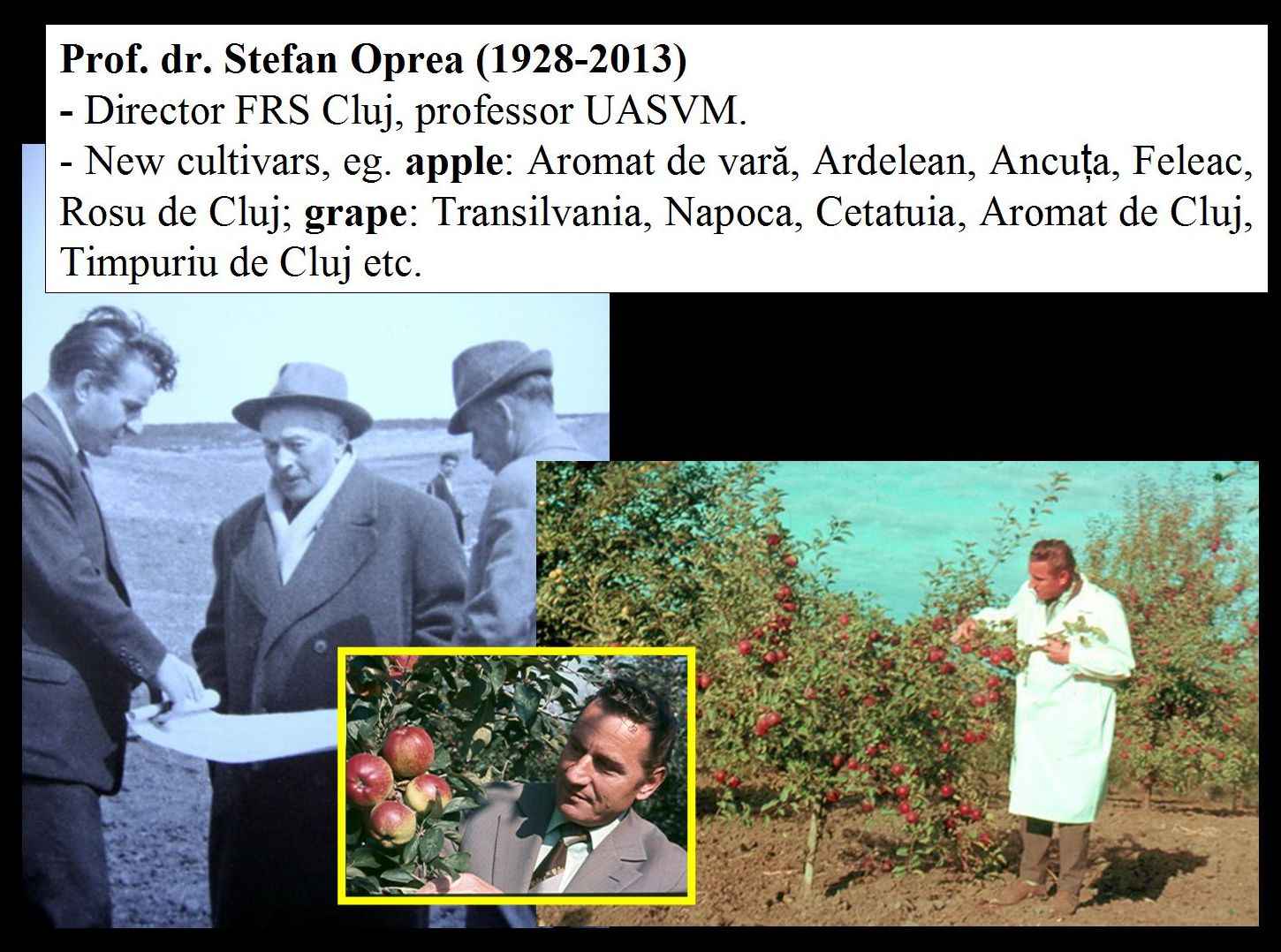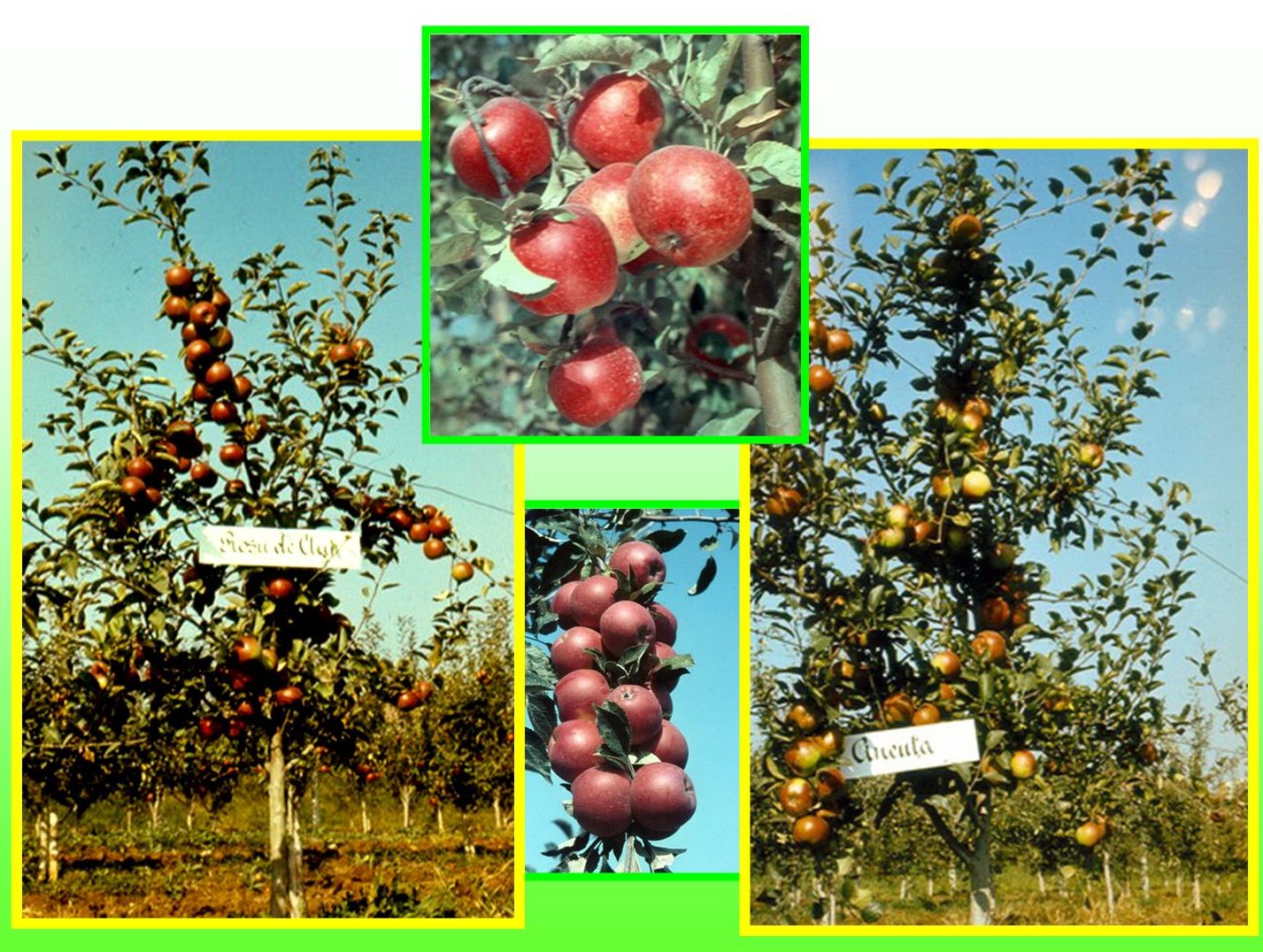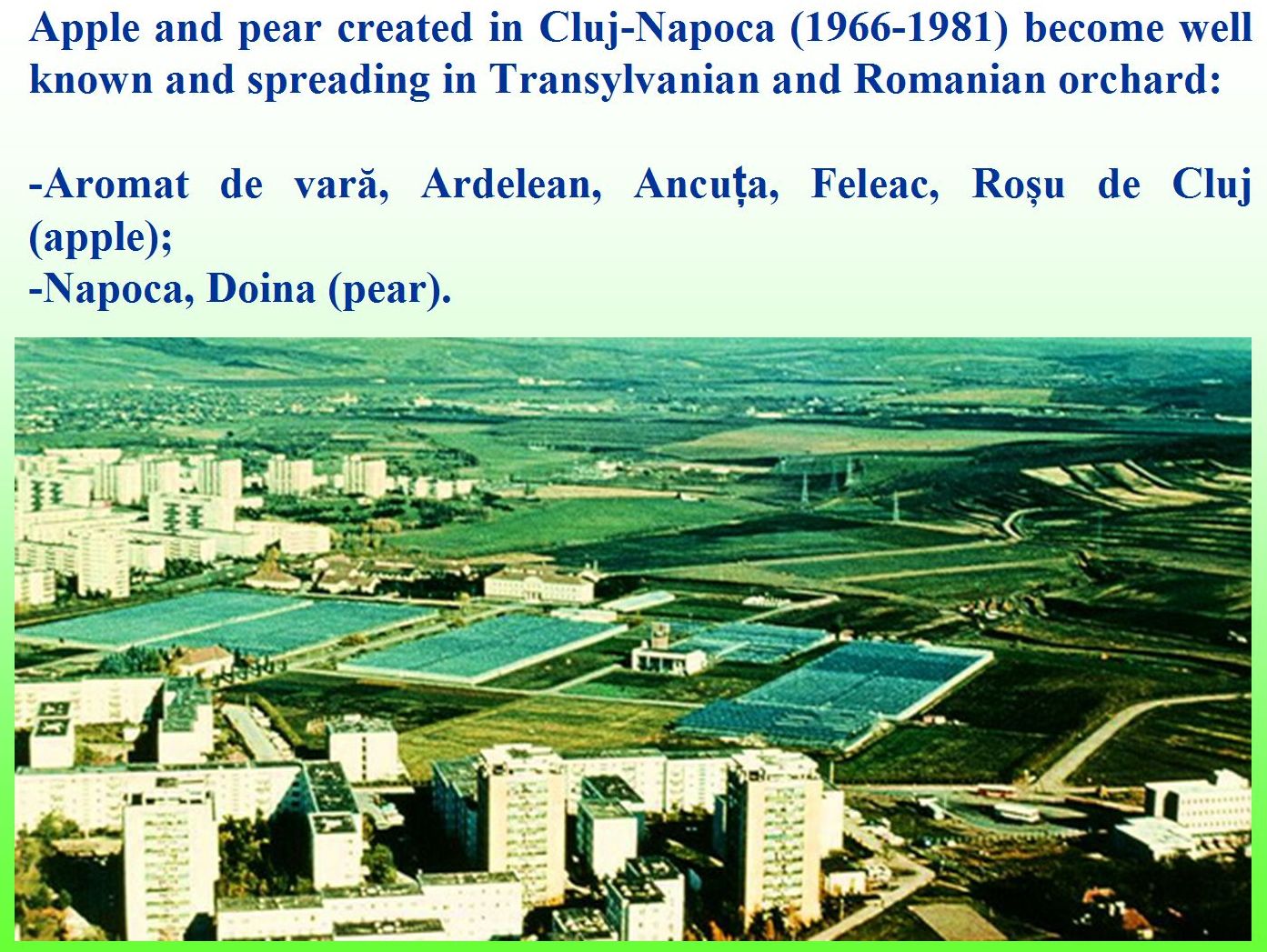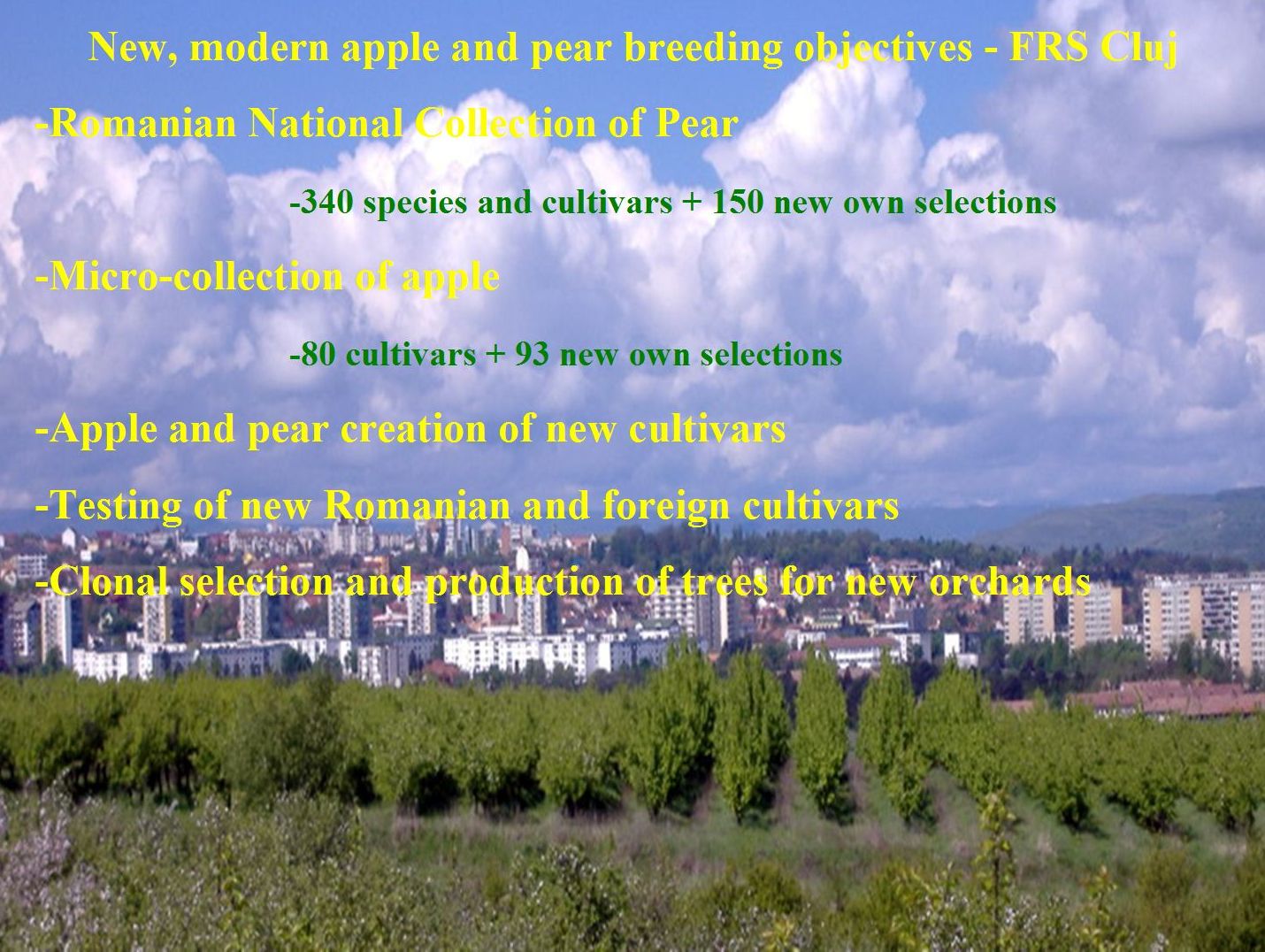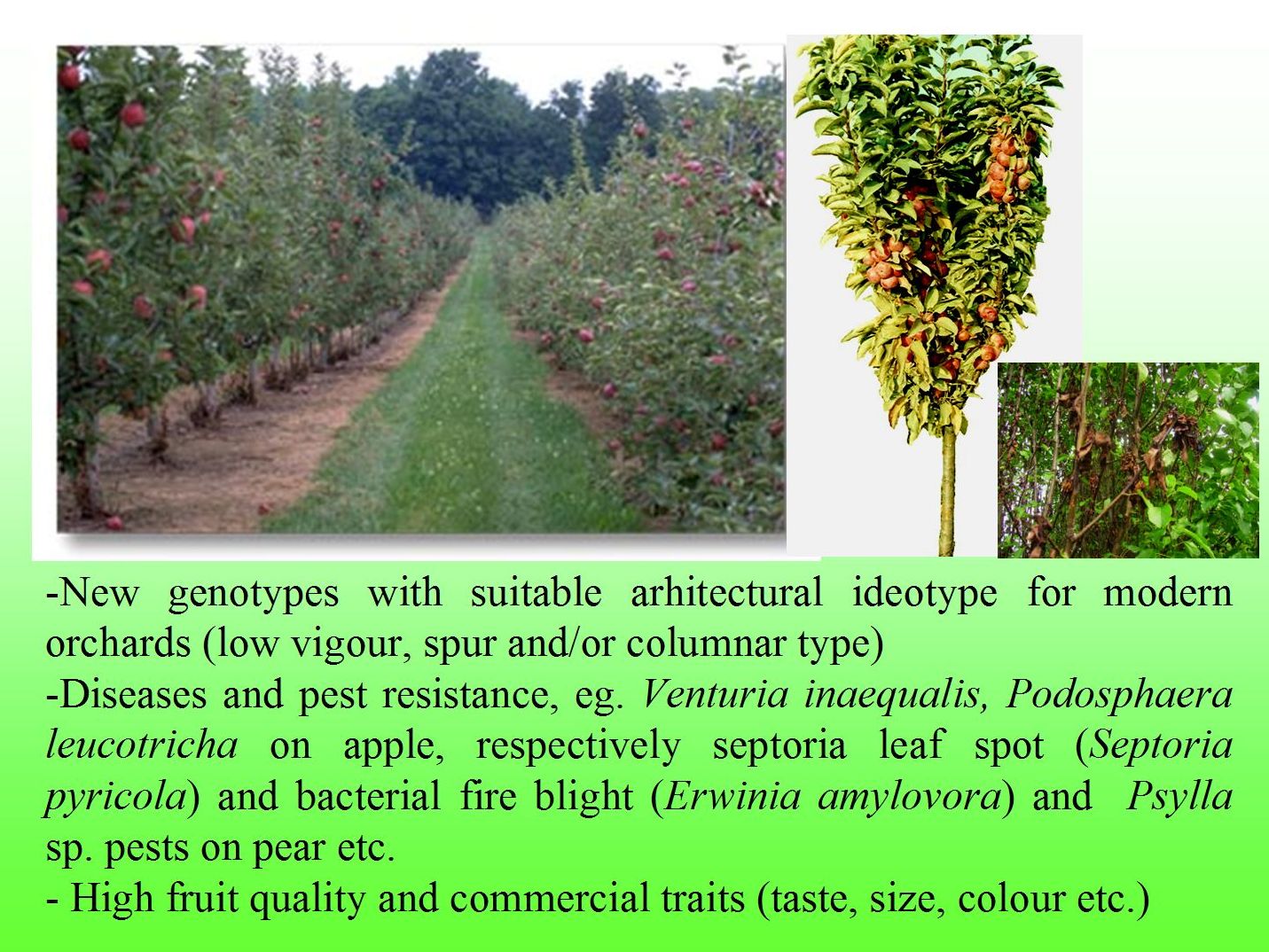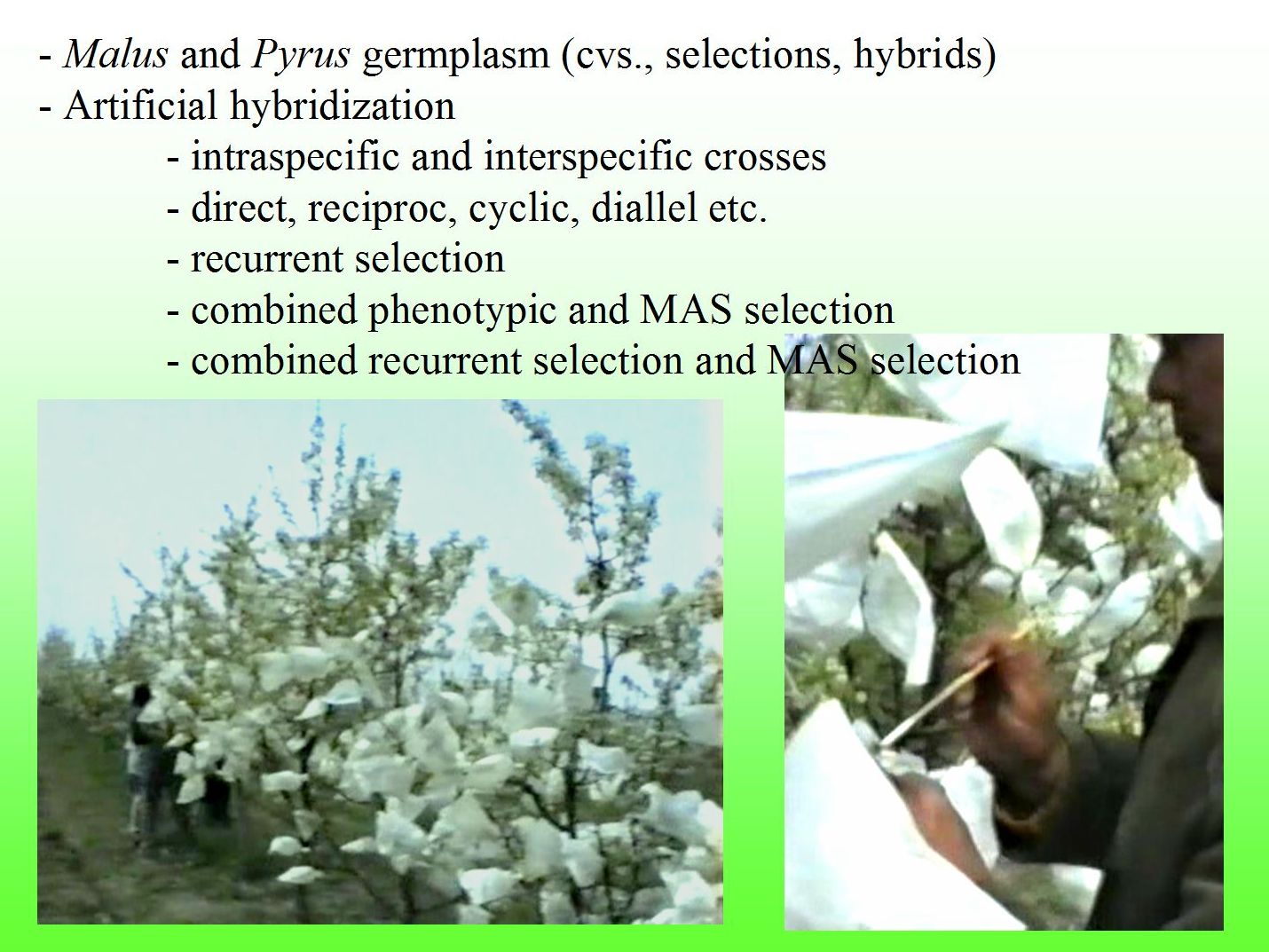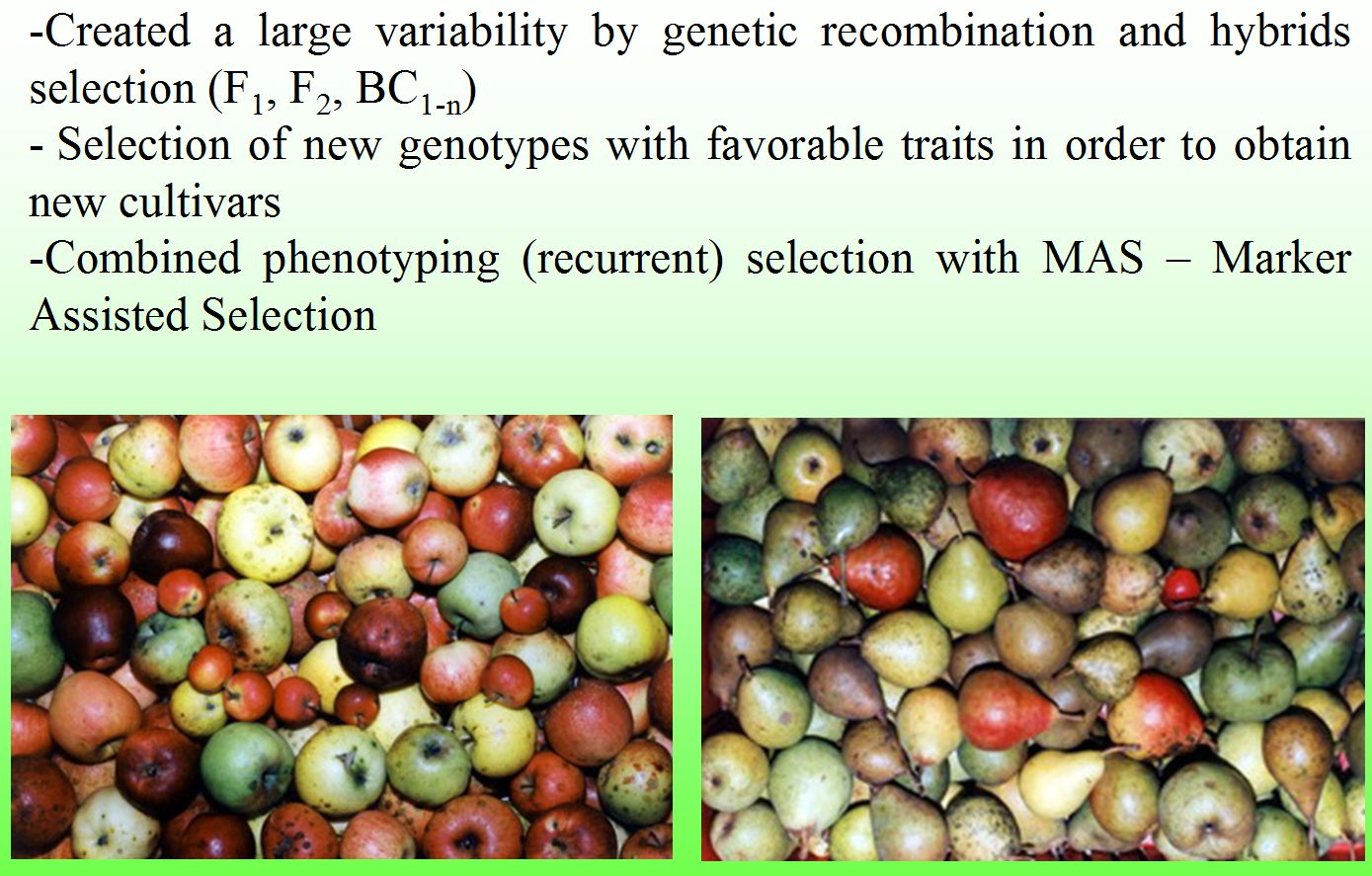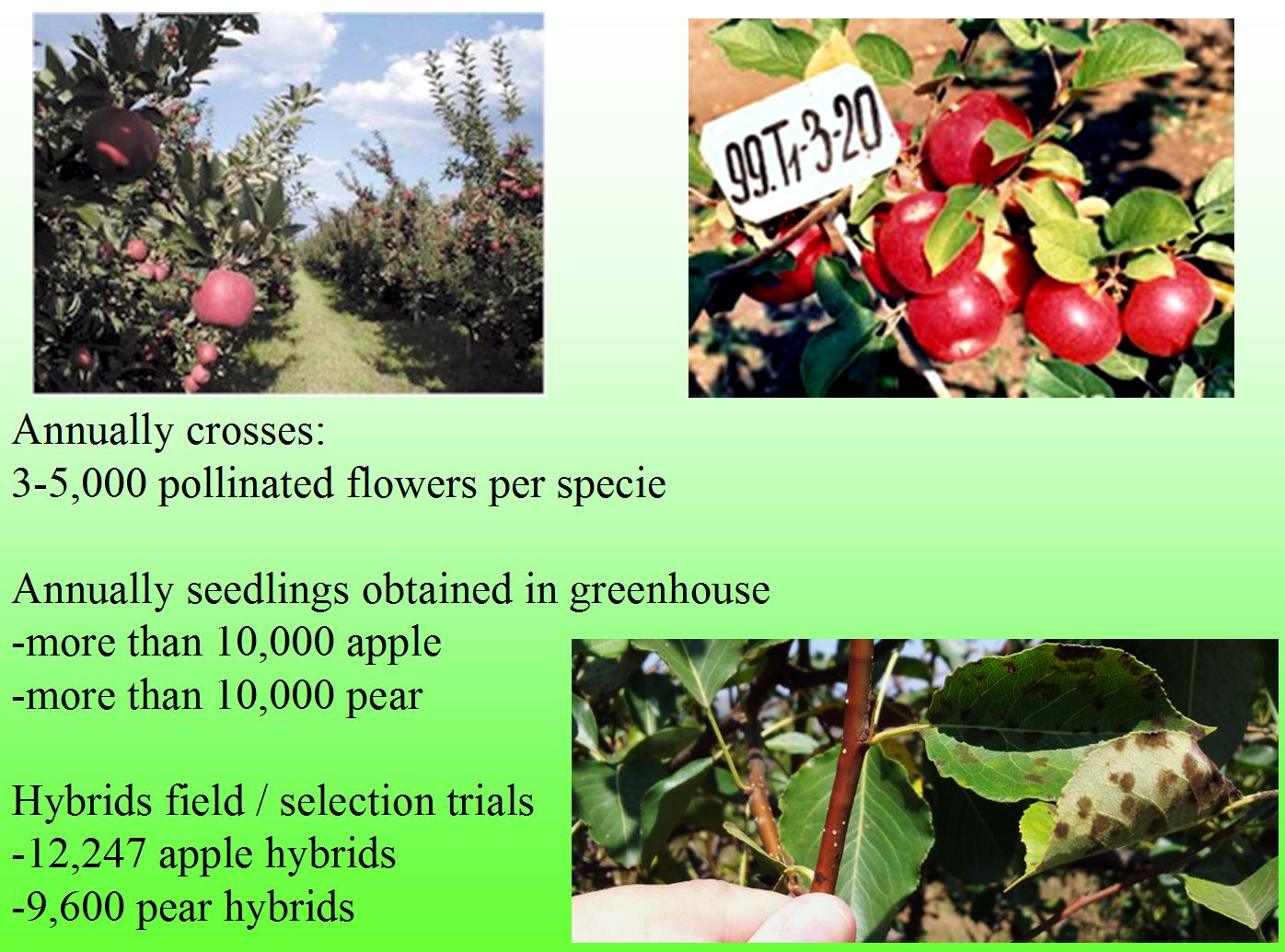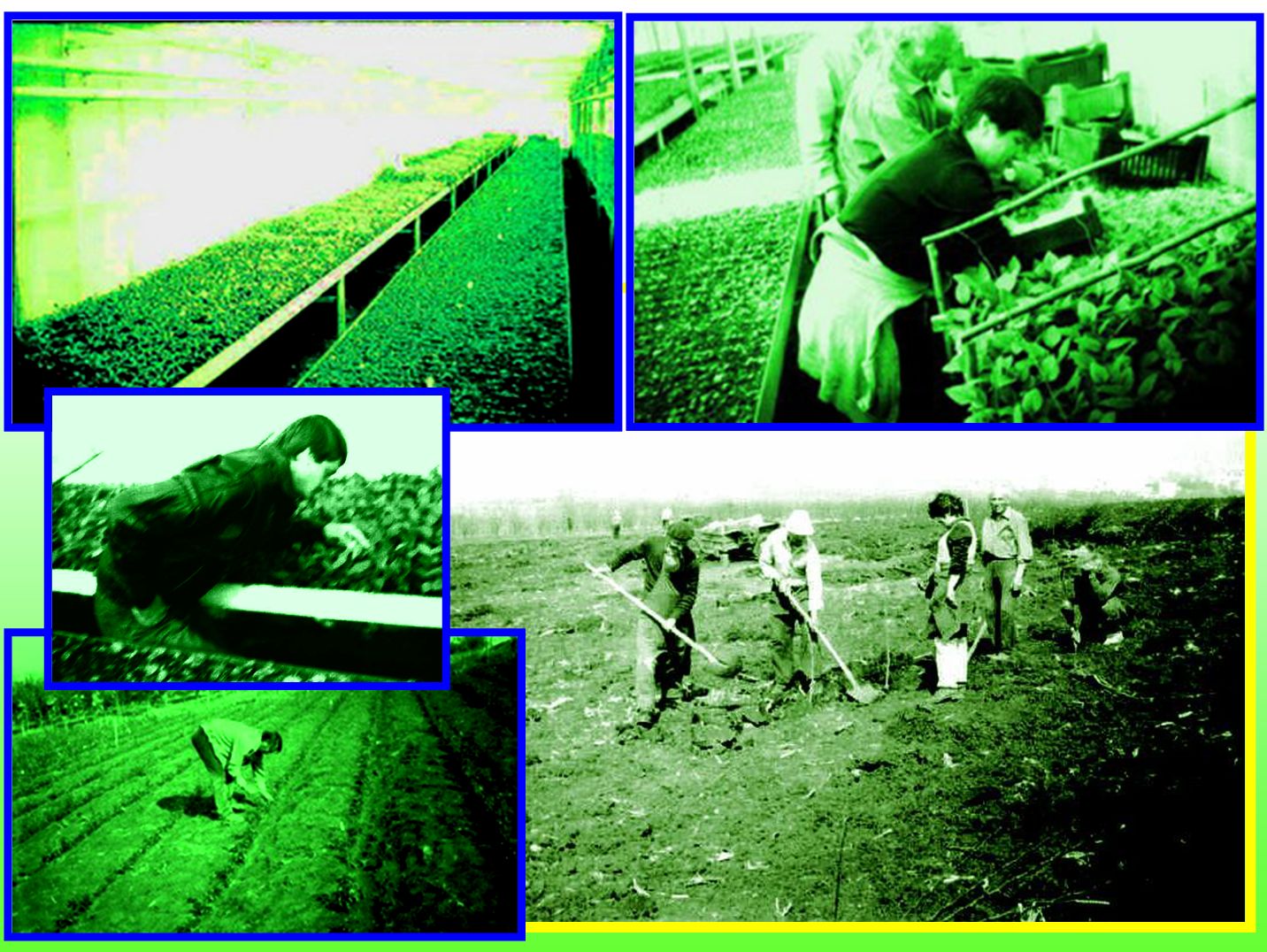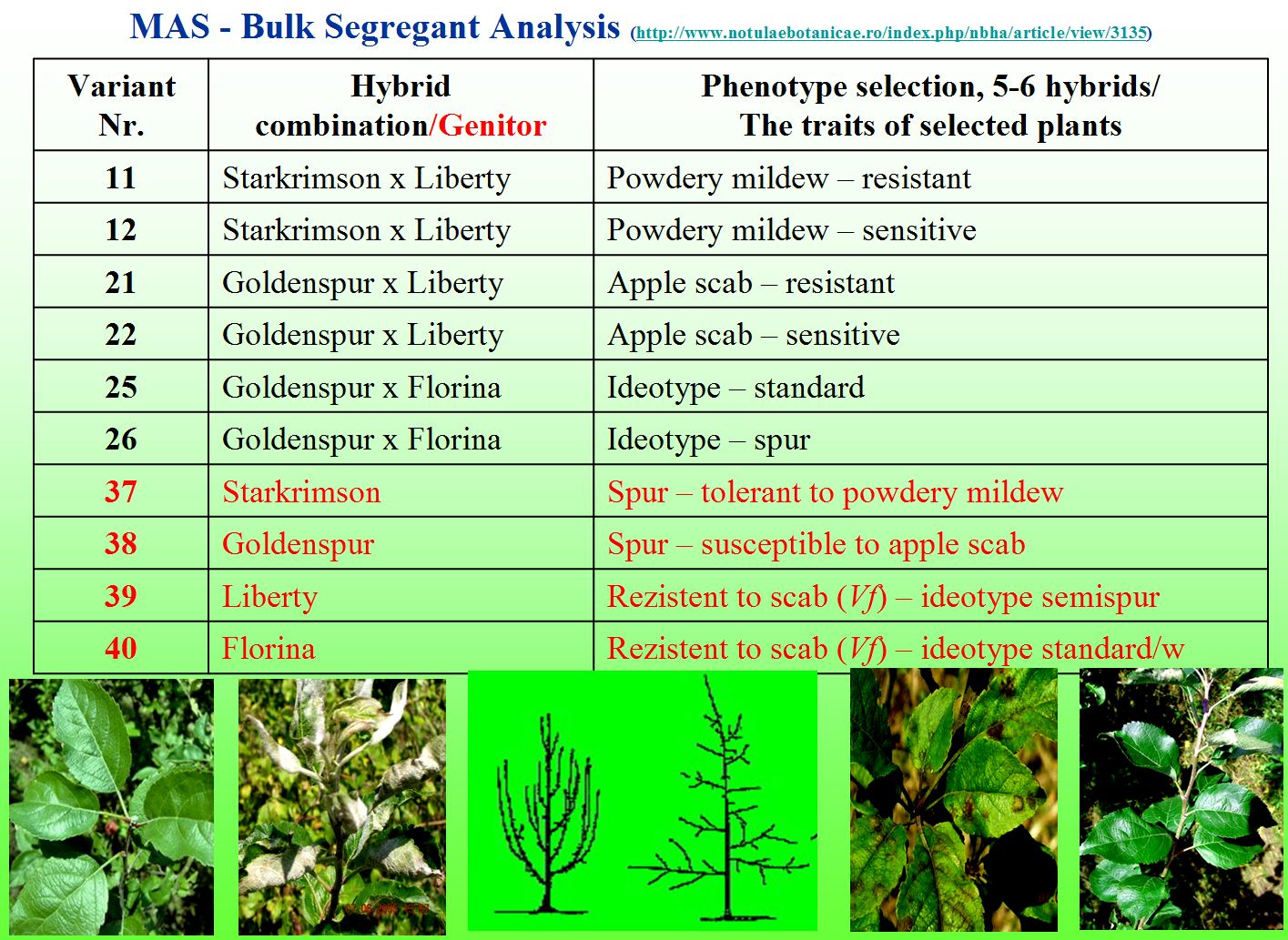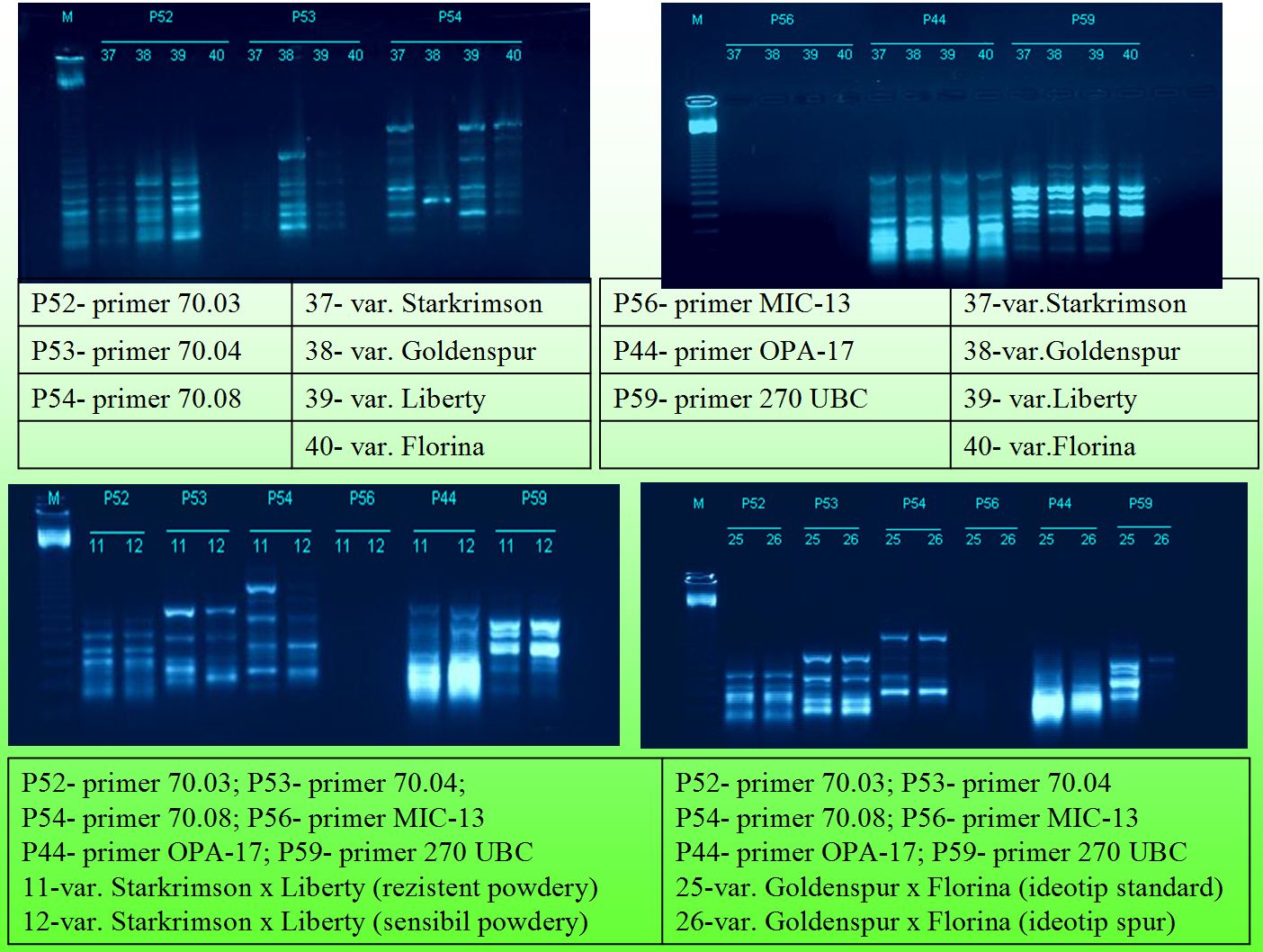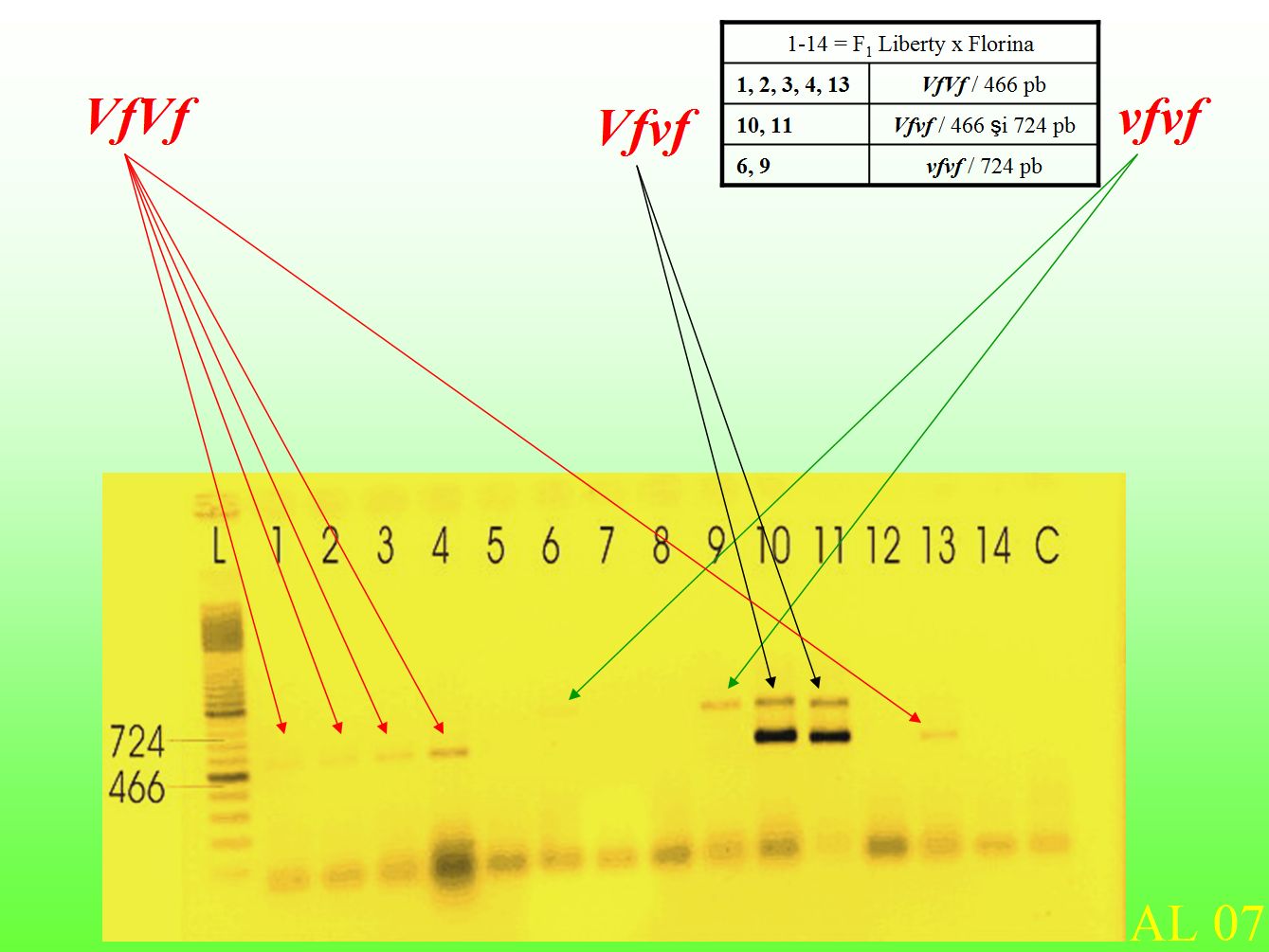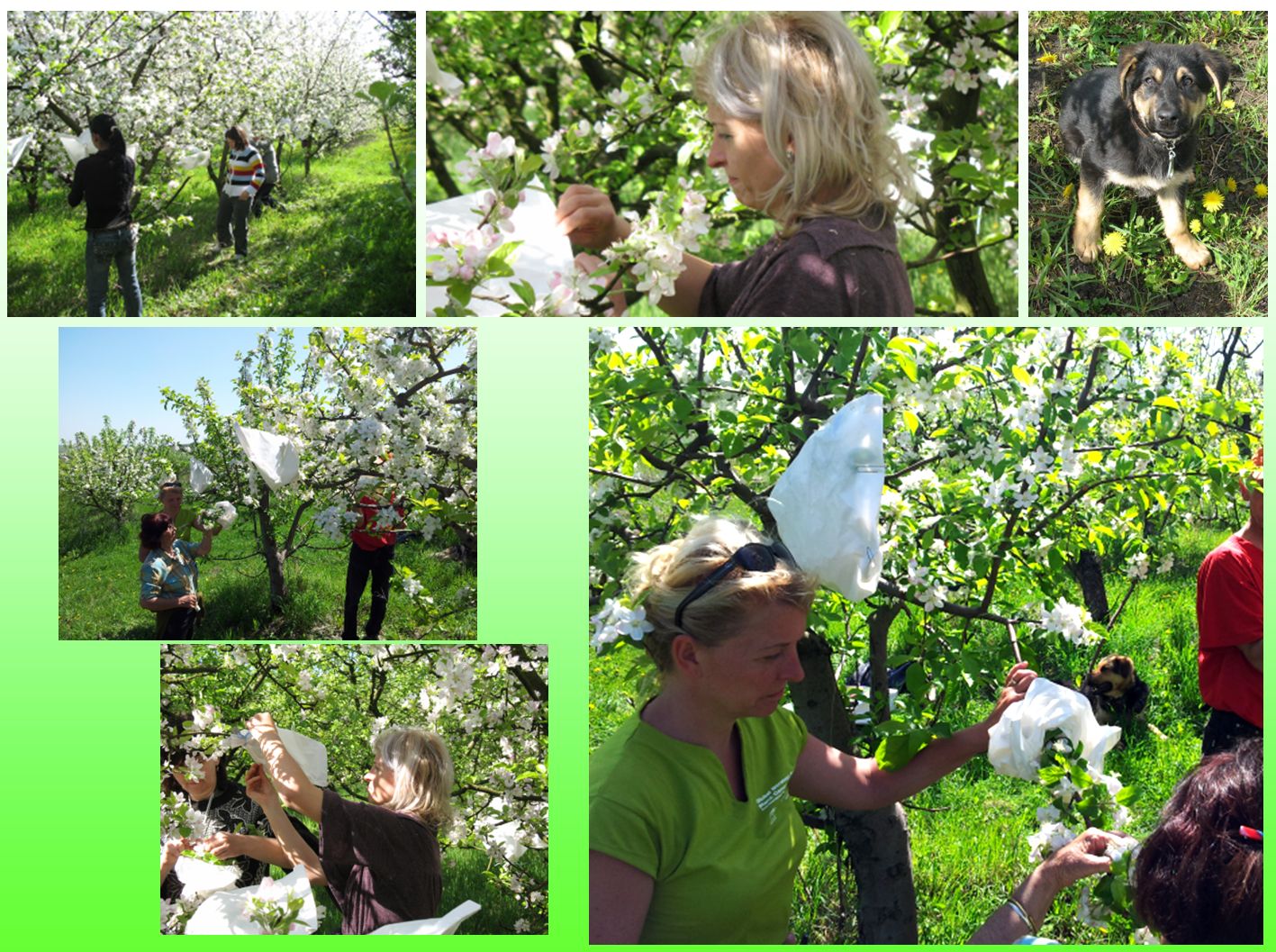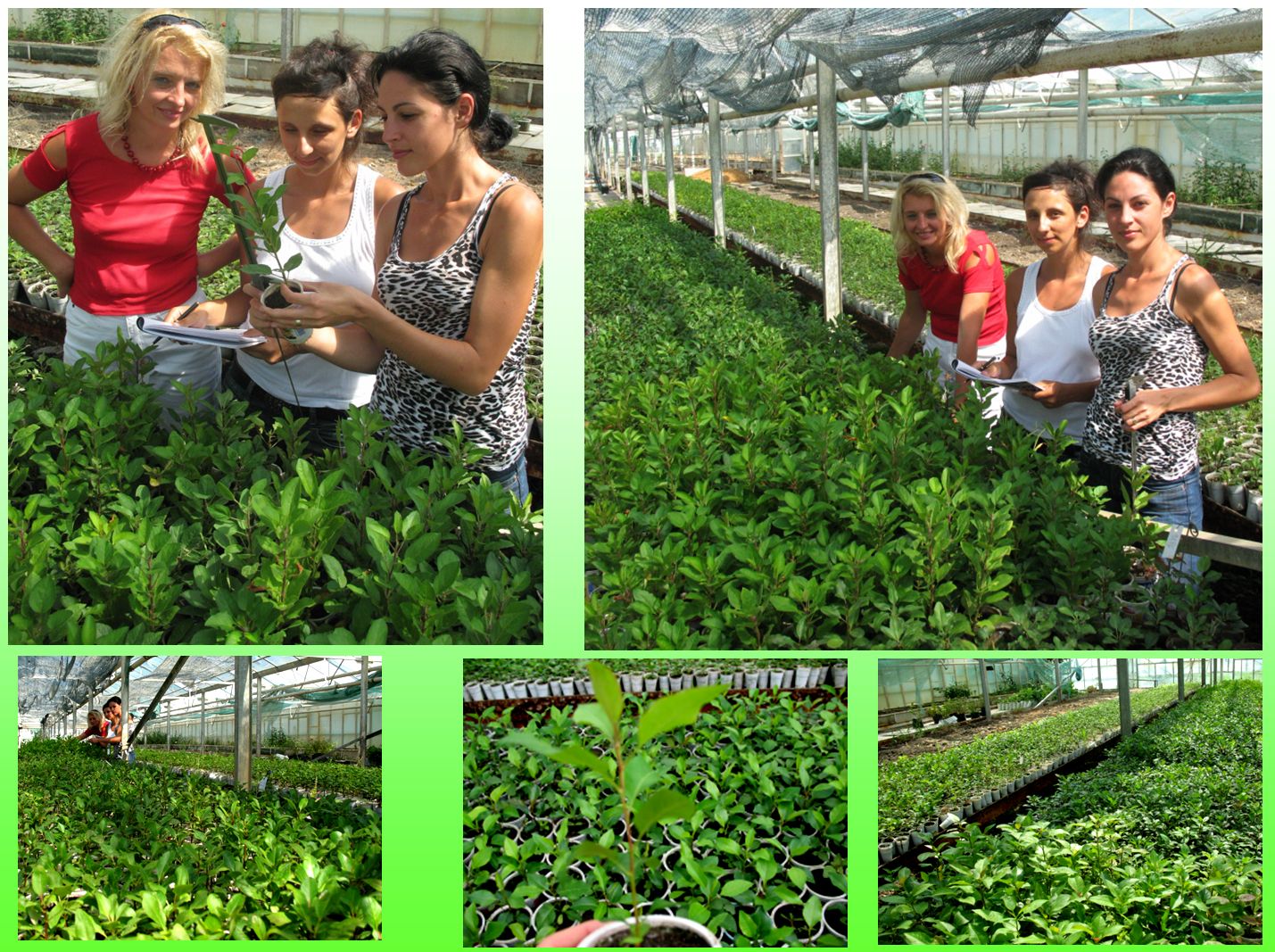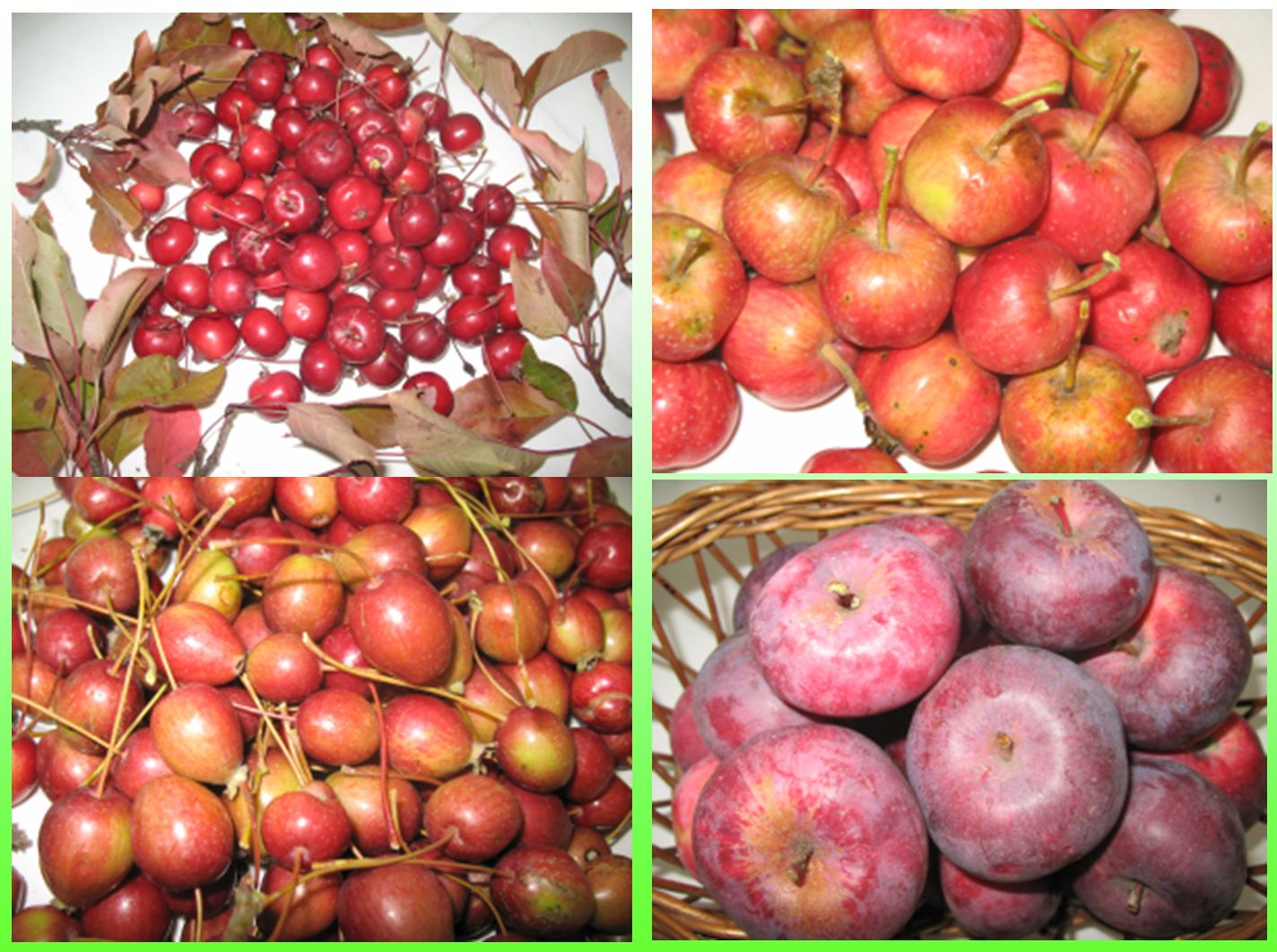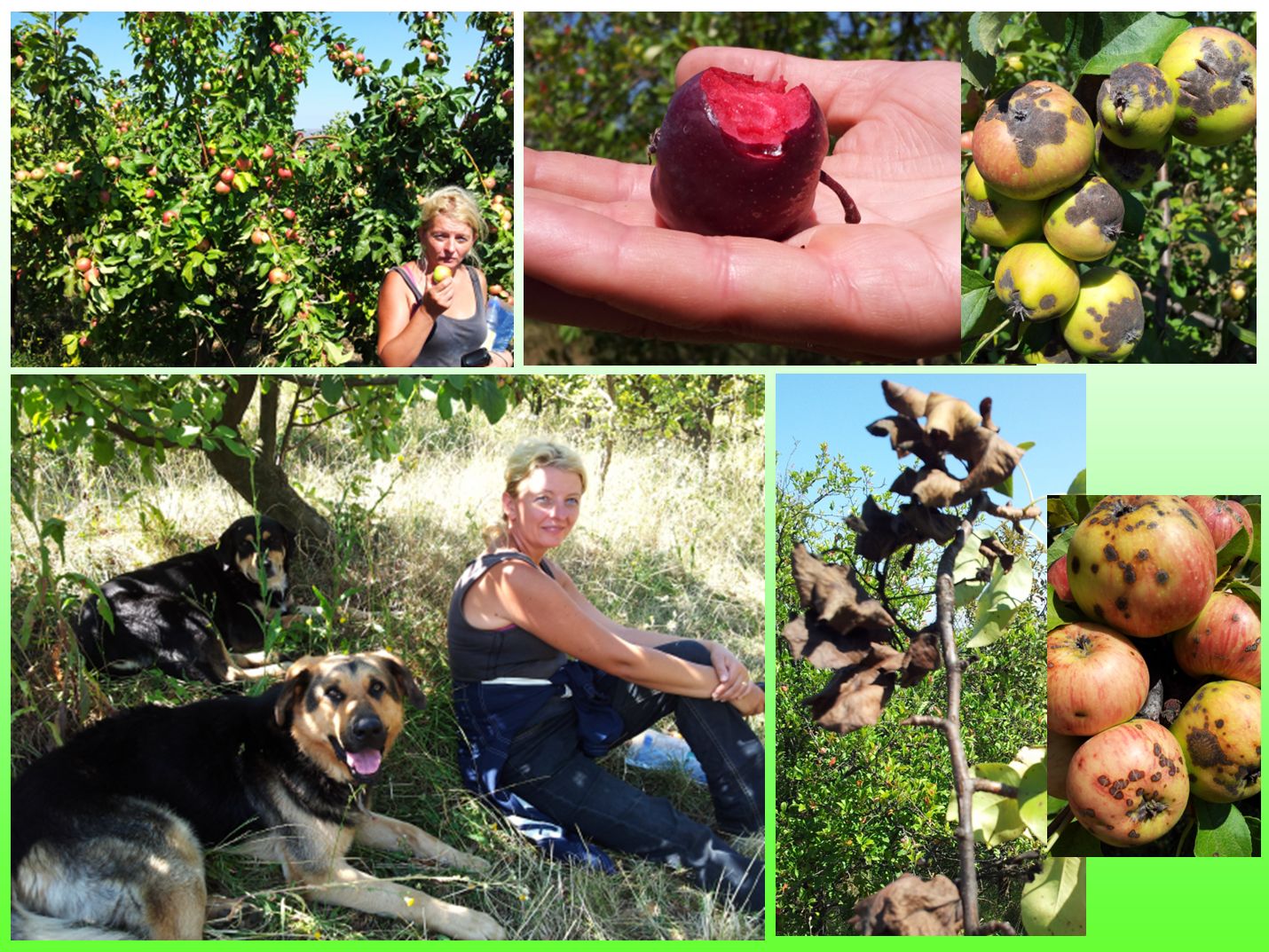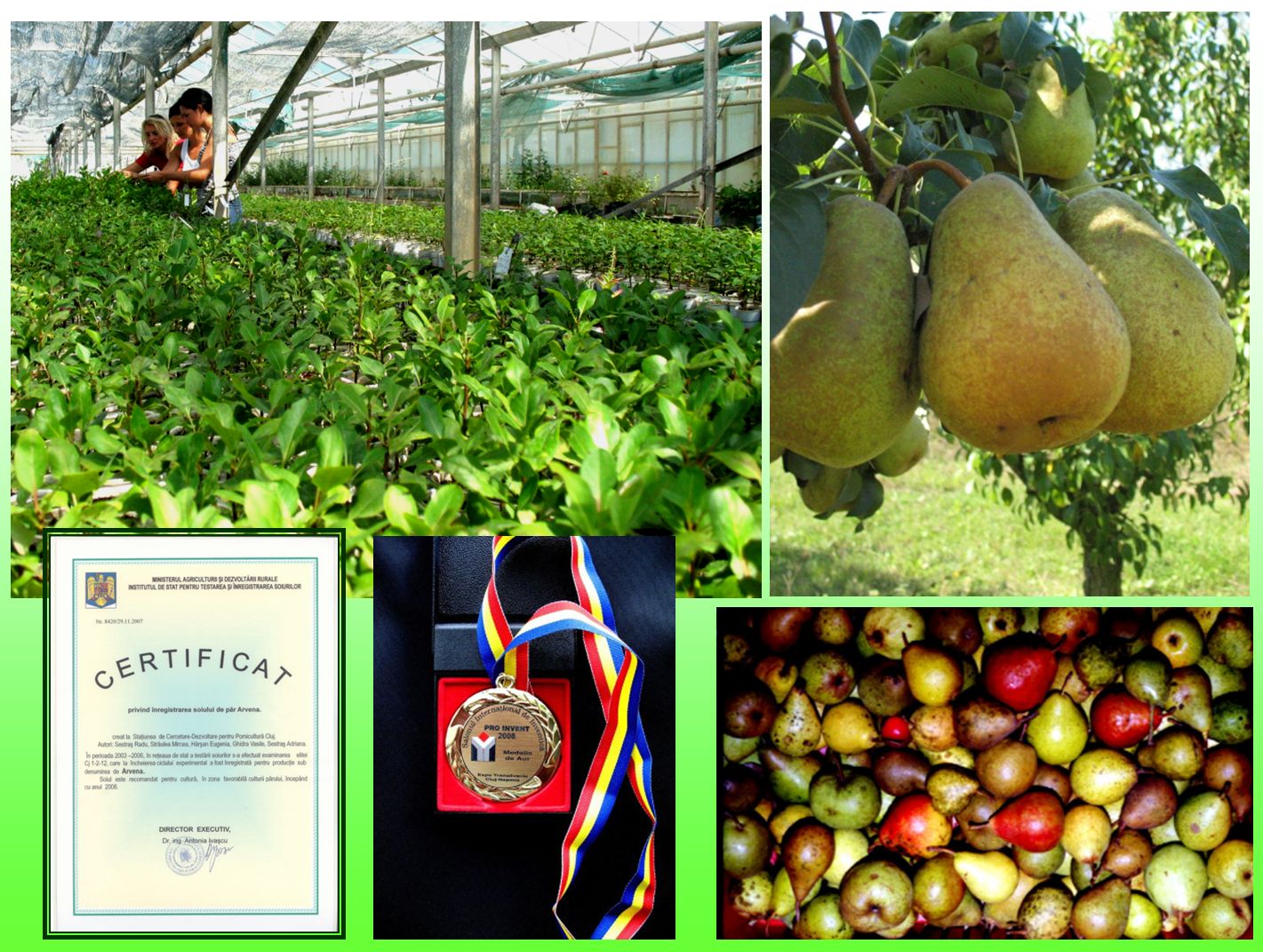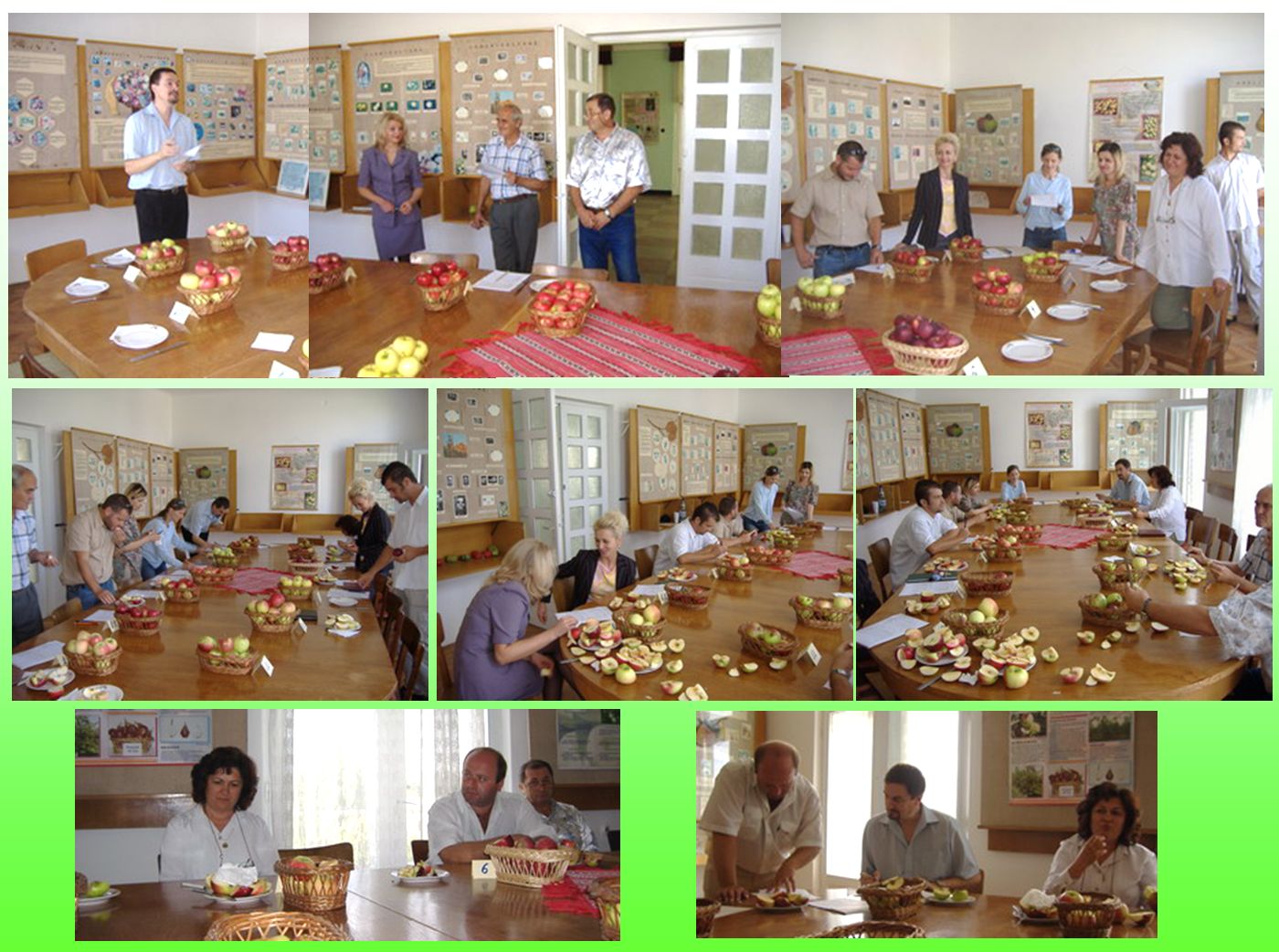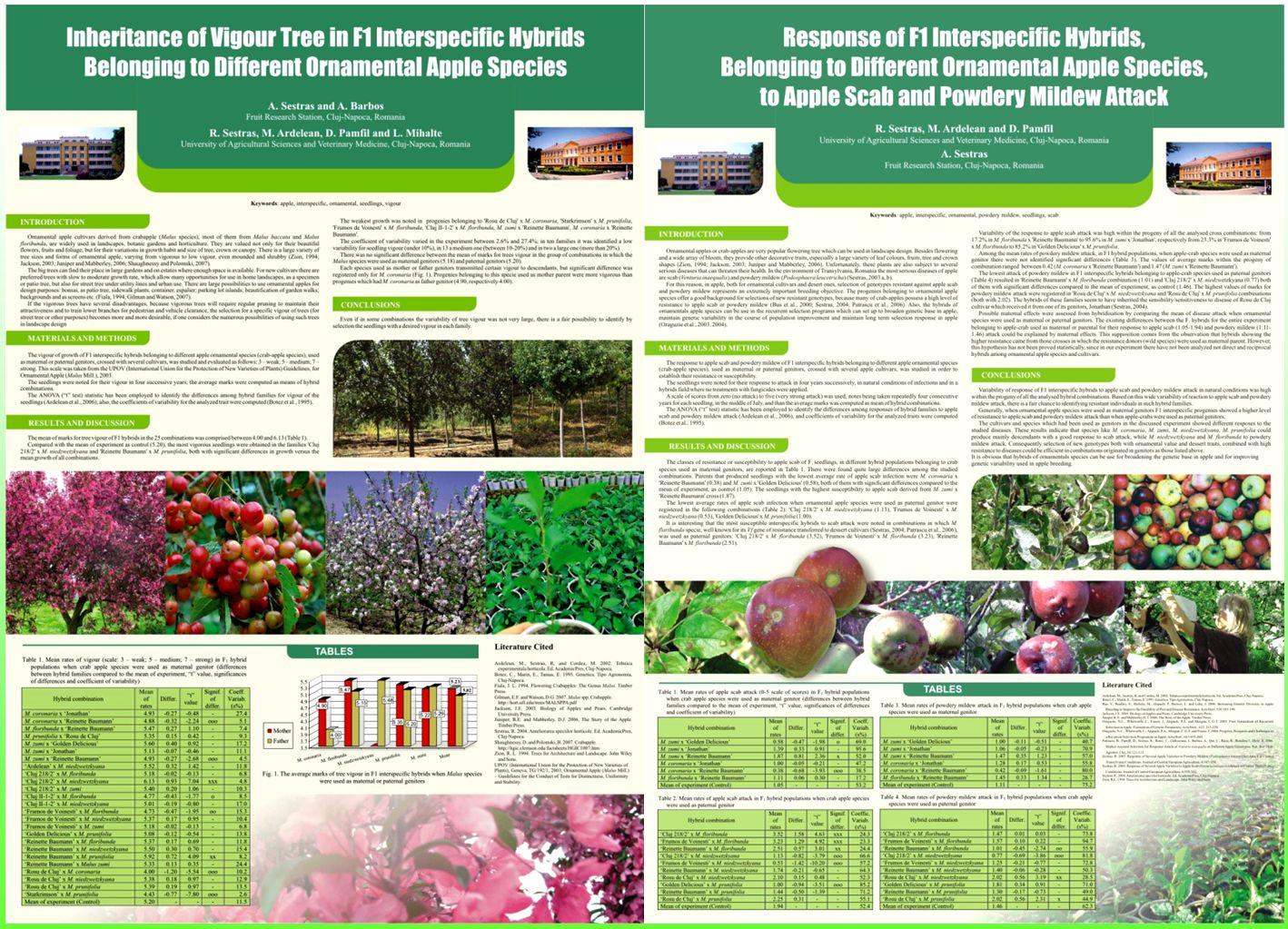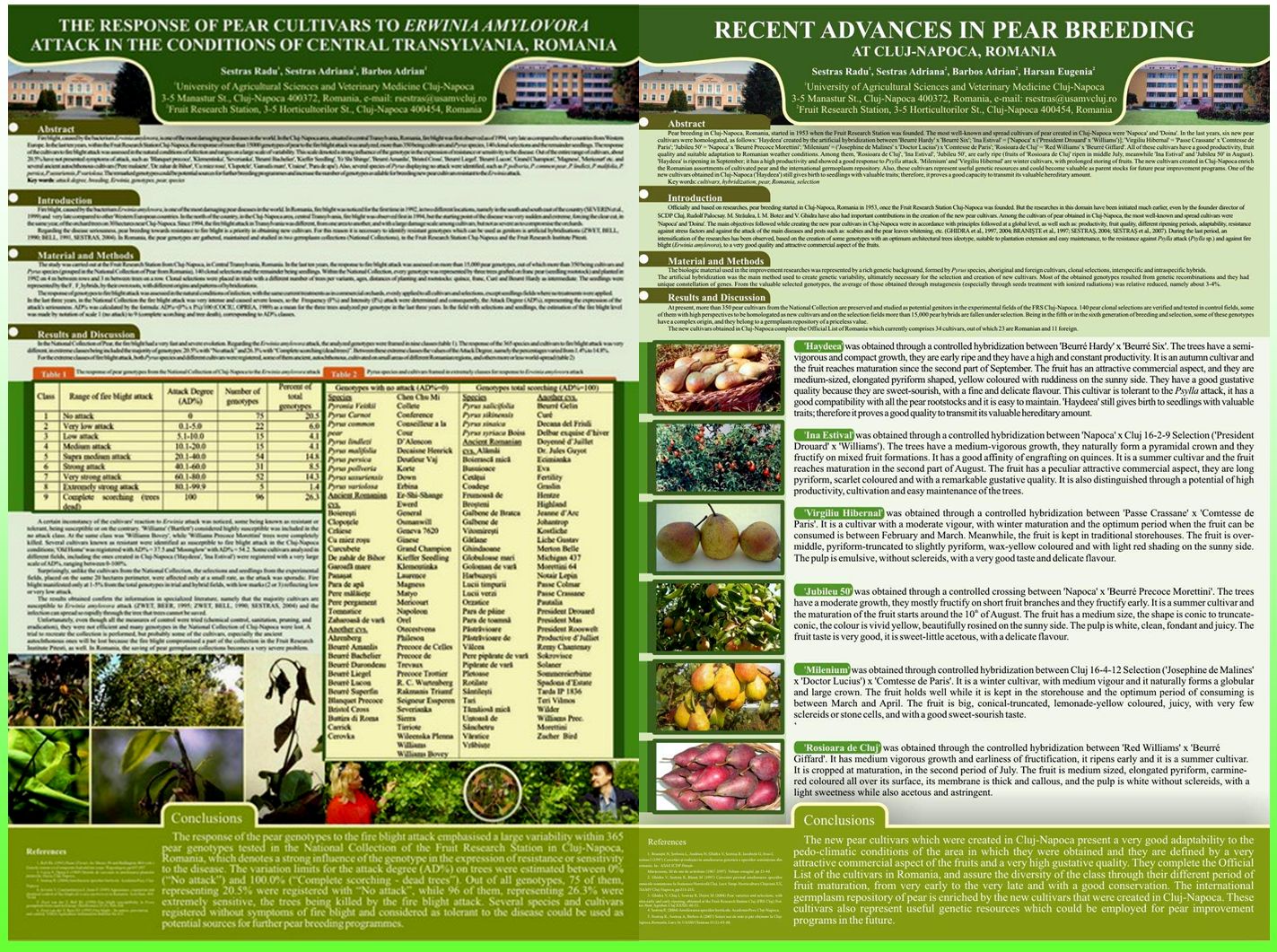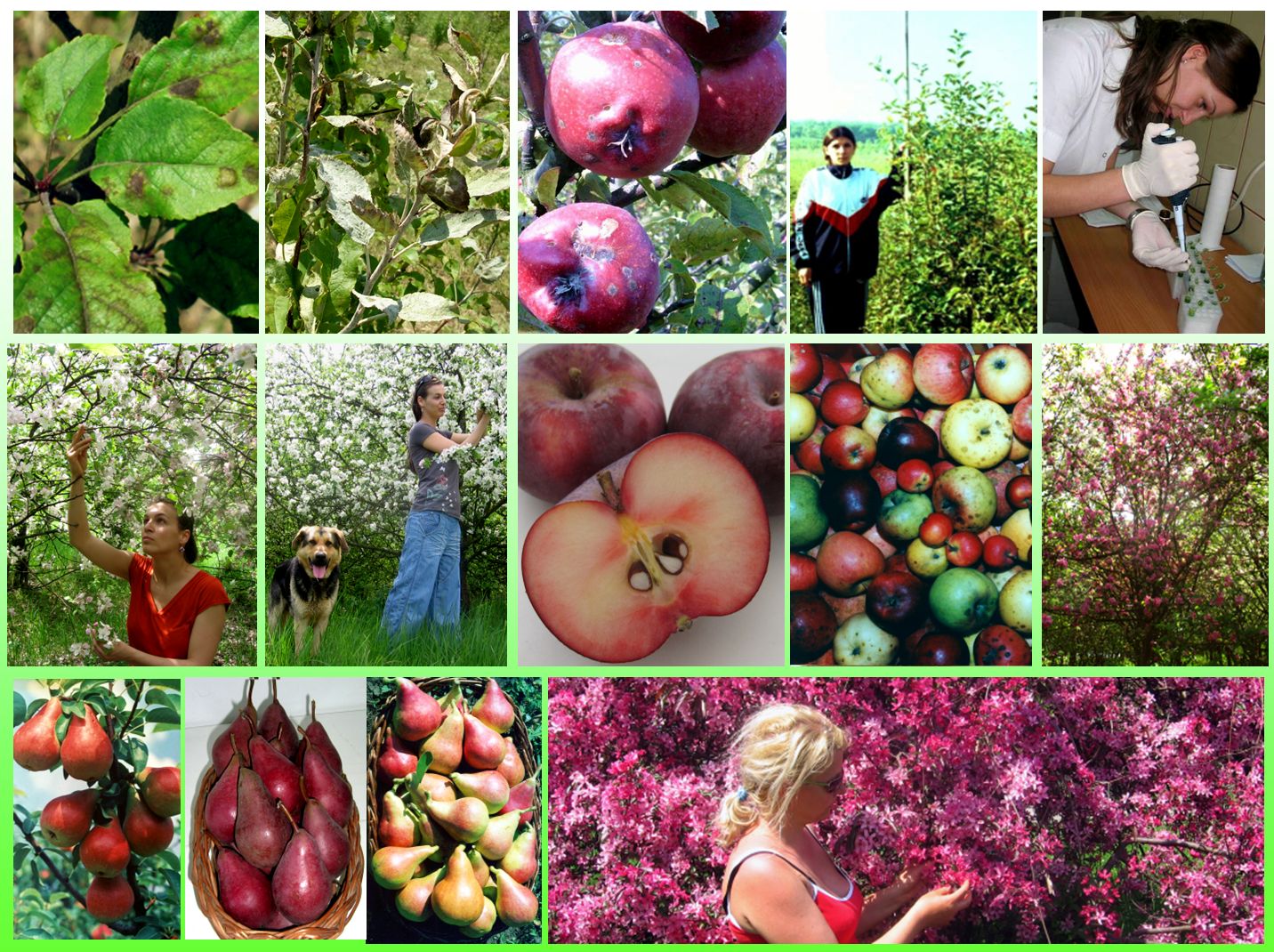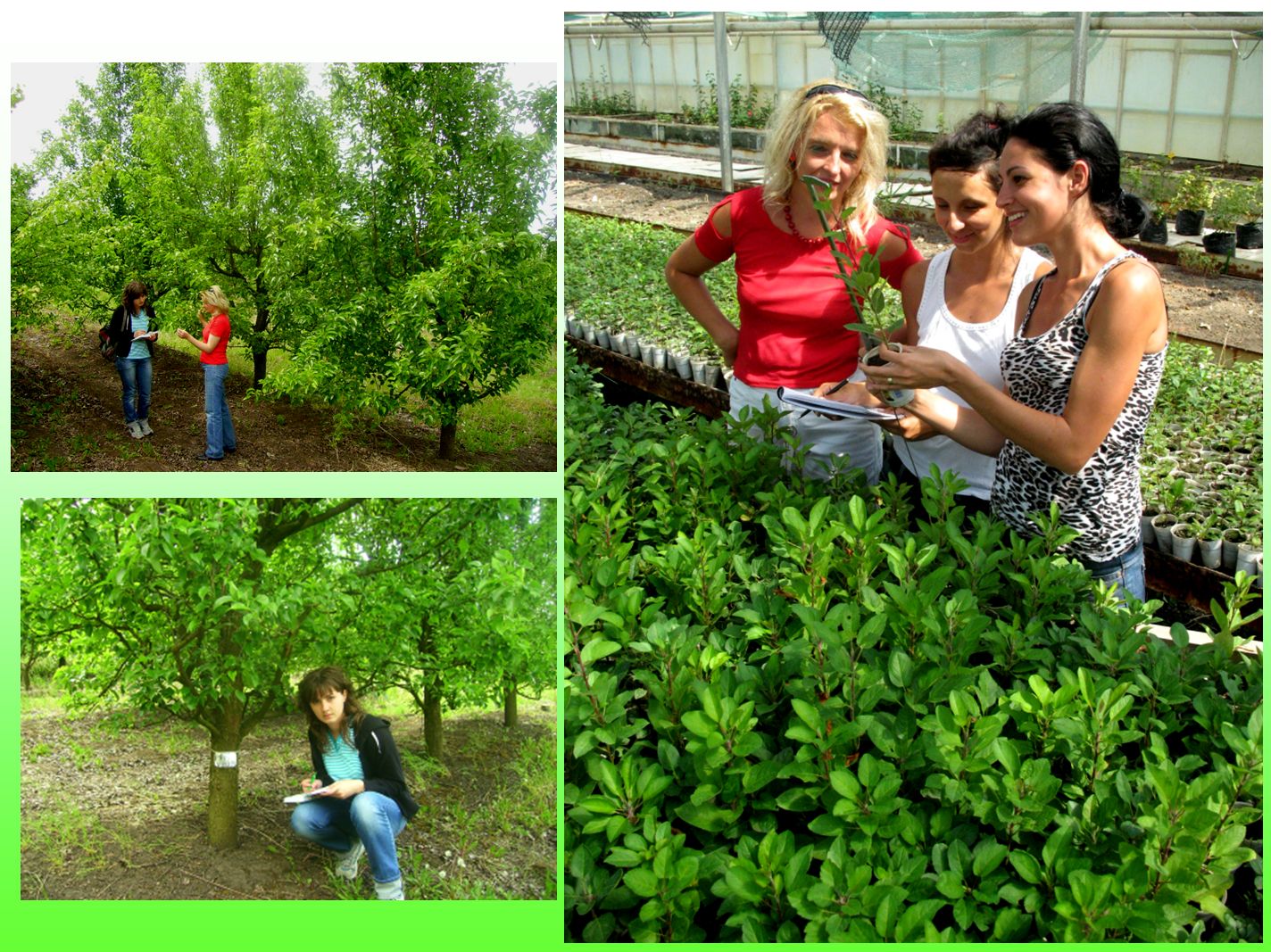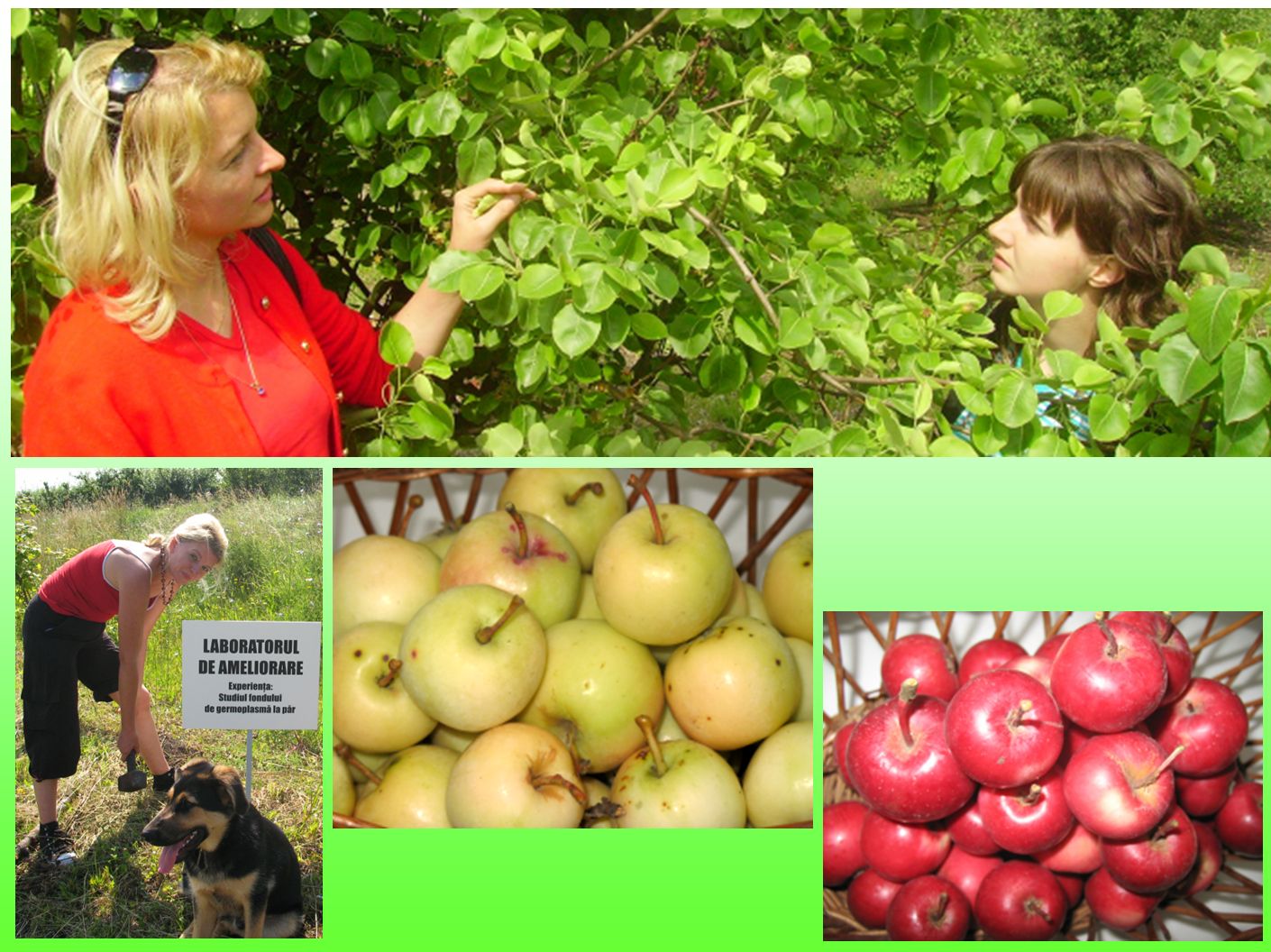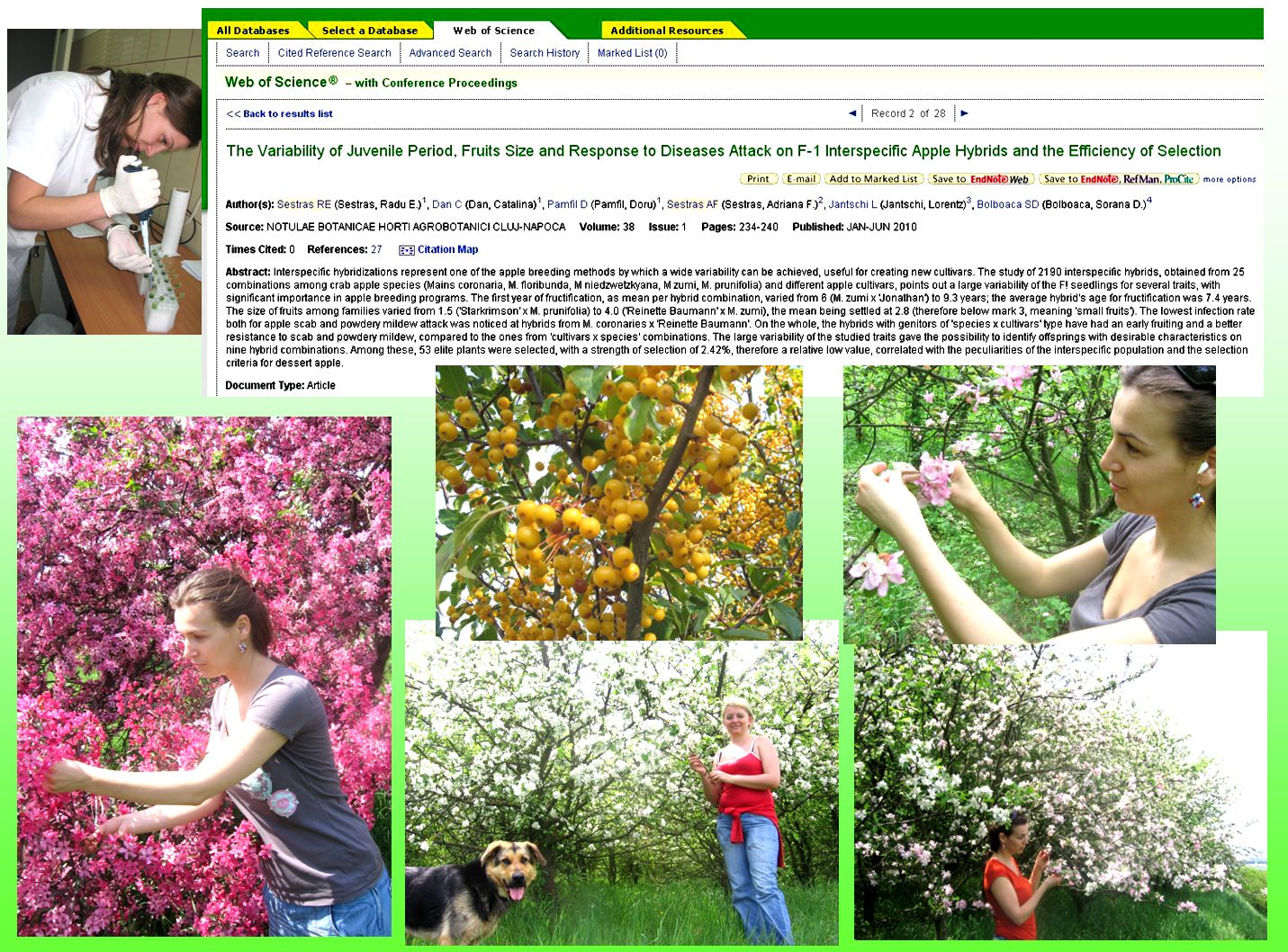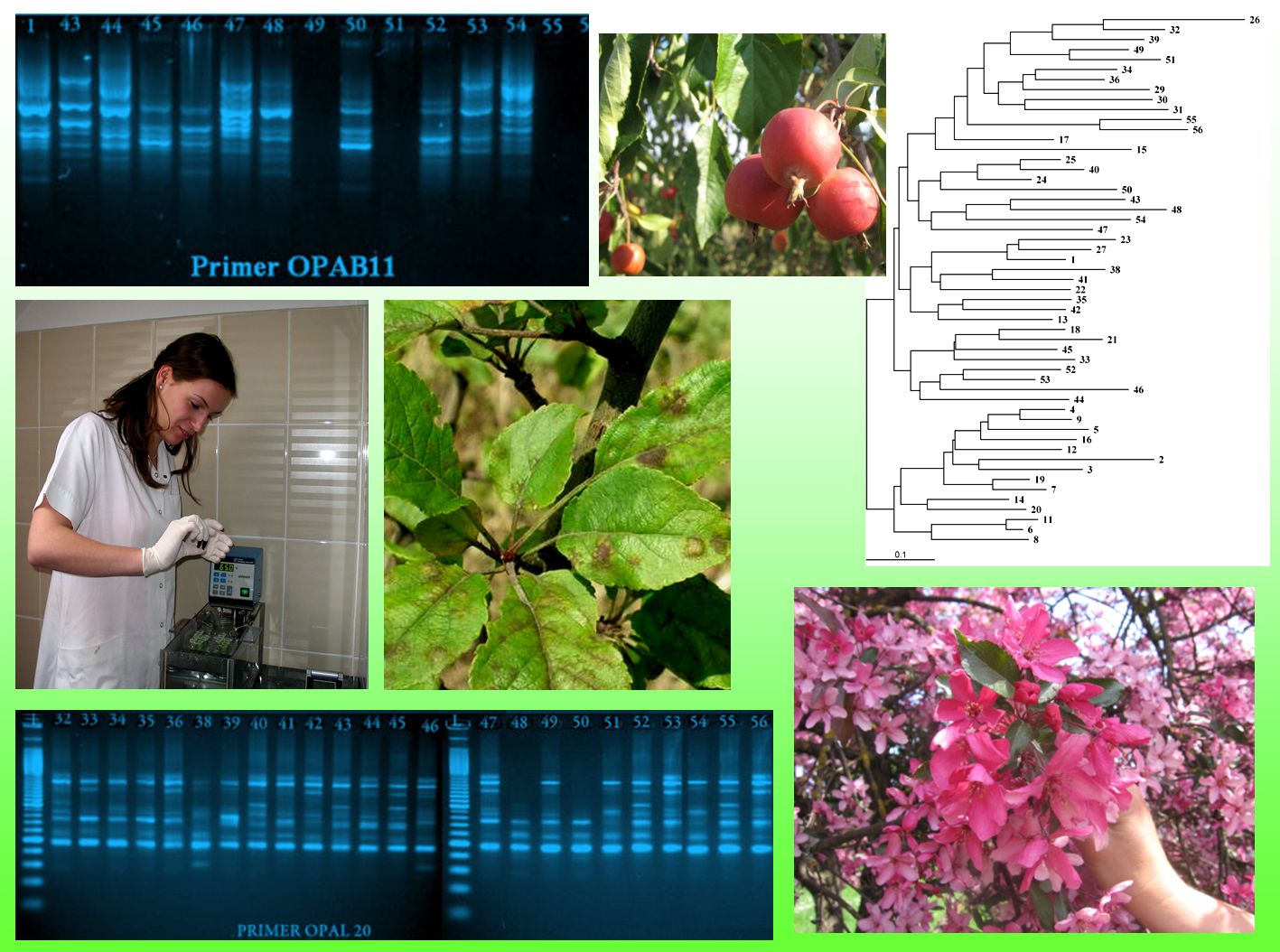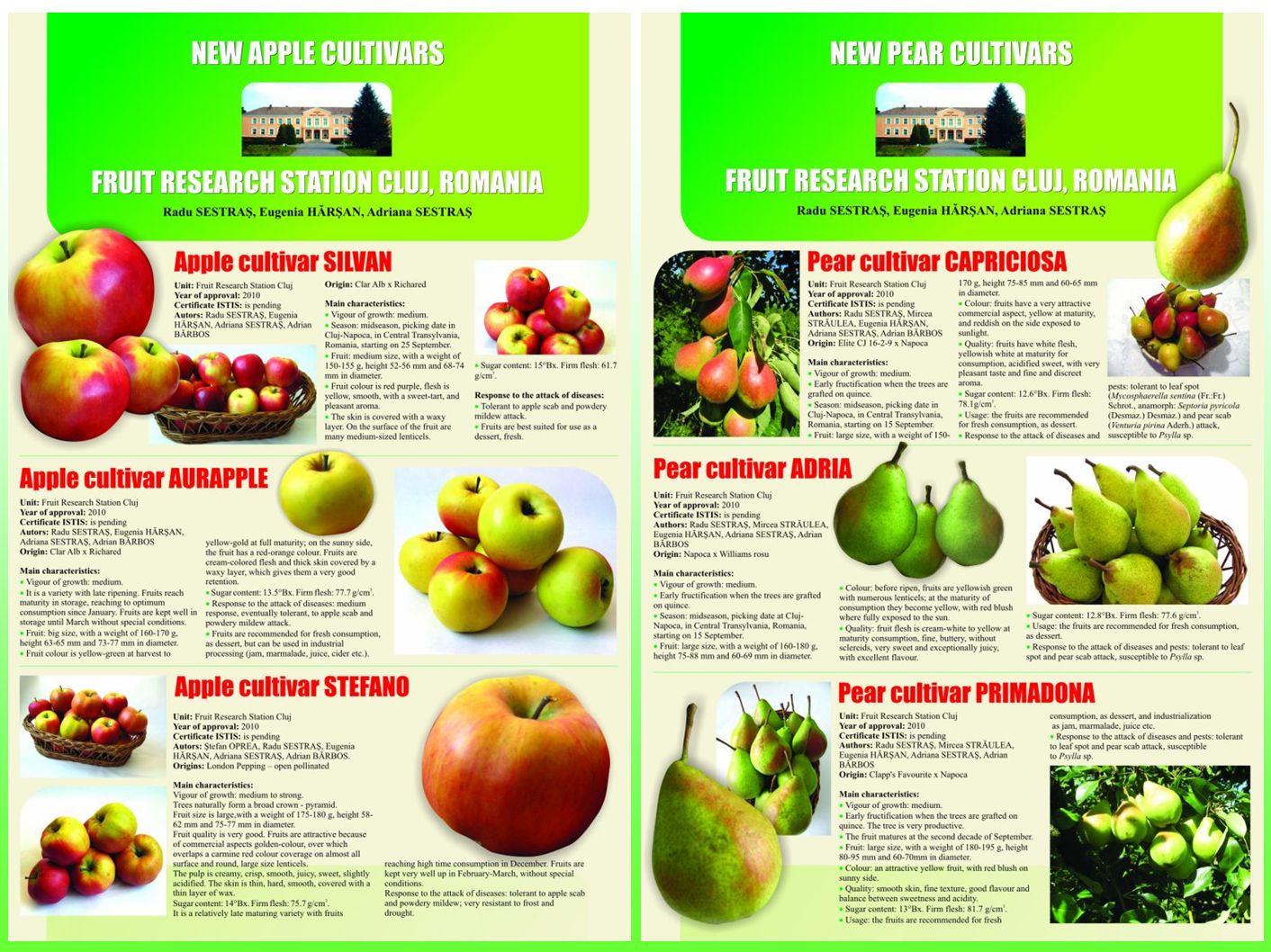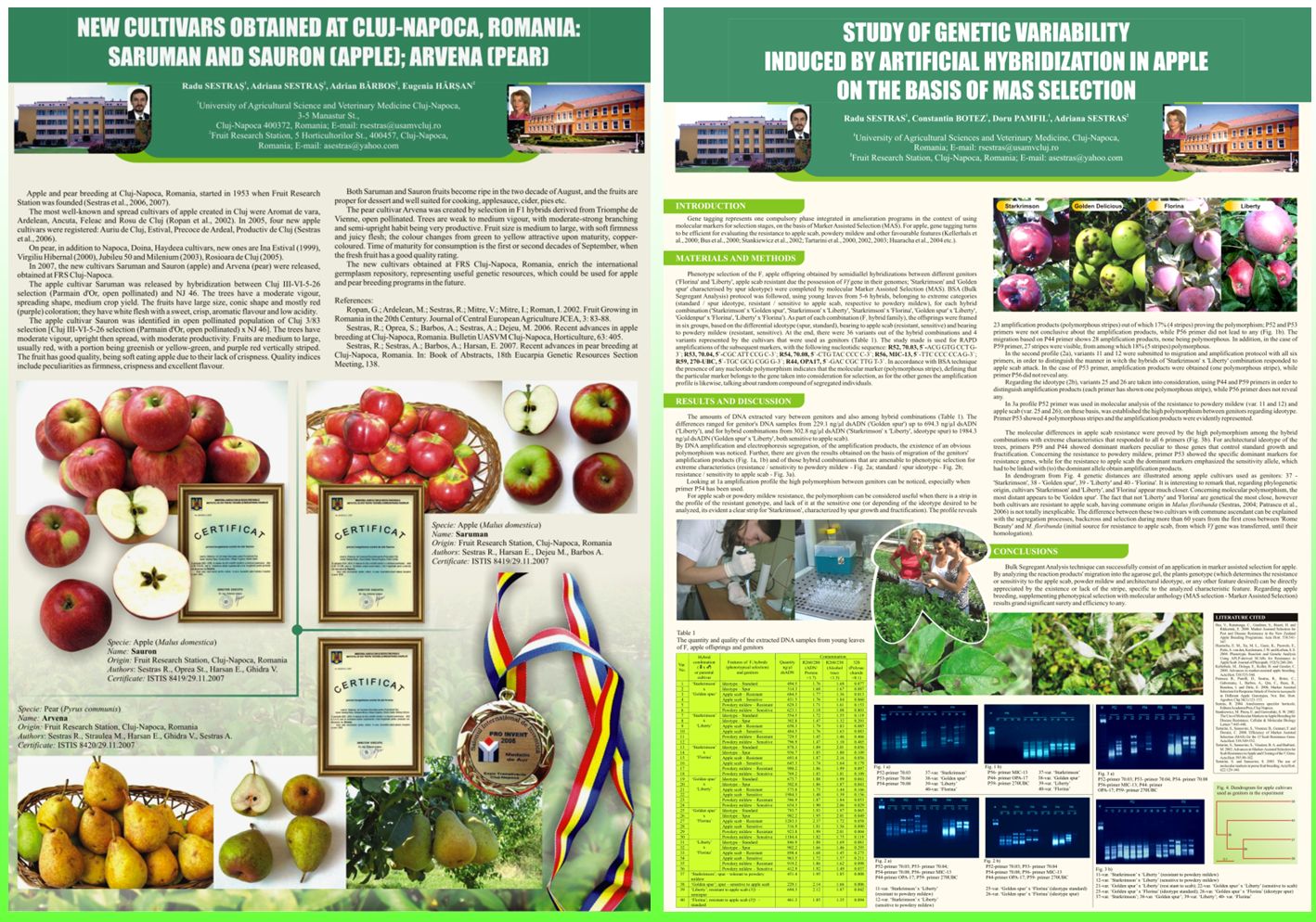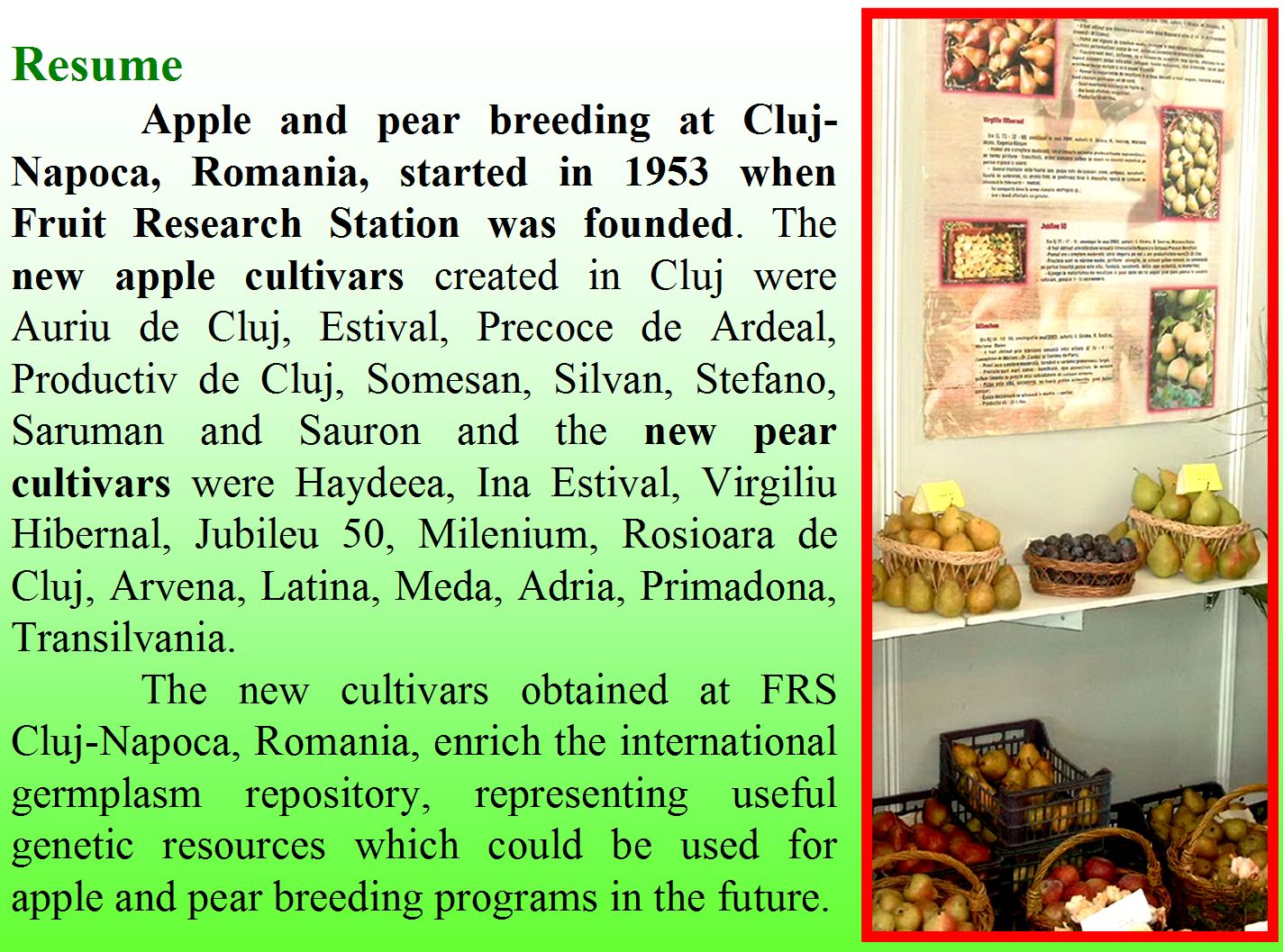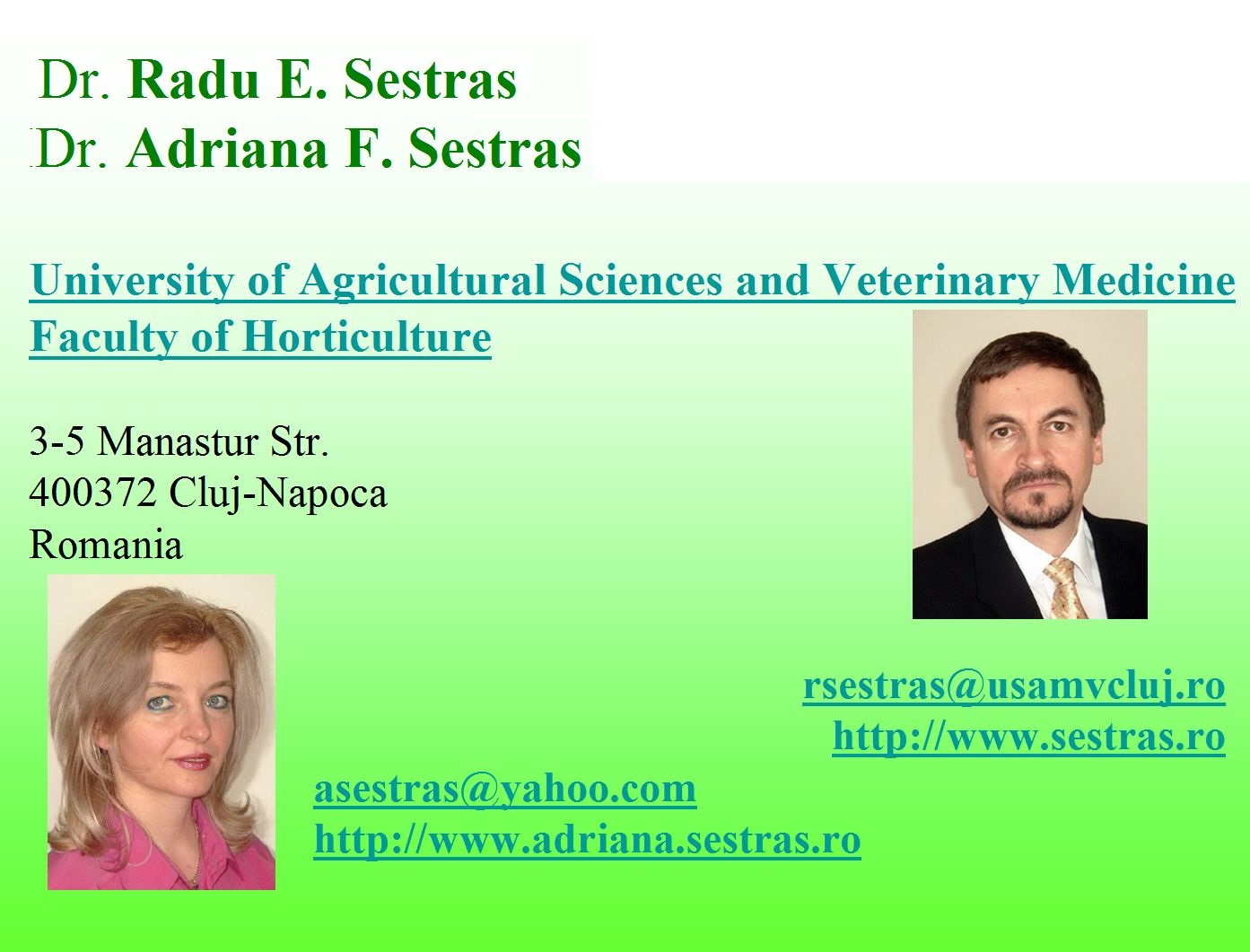Apple and pear breeding
in
Cluj-Napoca, Romania
History and breeding achievements on pome fruits in Cluj-Napoca, Romania; new creations, cultivars and selections with valuable edible traits, but also ornamental trees
Europe, Romania, Cluj-Napoca
University of Agricultural Sciences and Veterinary Medicine (UASVM) Cluj-Napoca,
Introduction – Generalities
Apple and pear – scientific classification
| Apple | Pear | |
| Family*: | Rosaceae | Rosaceae |
| Subfamily: | Maloideae | Amygdaloideae |
| Genus: | Malus (40 sp.) | Pyrus |
| Specie: | M. domestica | P. communis |
Different cultivars are created for various tastes and use, including fresh eating, cooking and cider production. Also, there are ornamental apple and pear trees.
Domestic apples and pears are generally propagated by grafting, although wild species grow readily from seed.
Trees are prone to a number of fungal, bacterial and pest problems, which can be controlled by a number of organic and non-organic means.
Apple scab
Importance
World’s most important temperate fruit crops:
Apple ≈ 70 million tons/yr.
Pear ≈ 22.5 million tons/yr.
Apple – leading producers:
China
United States
Turkey
Italy
Worldwide apple production
|
Country
|
Production (mil tonnes)
|
|
China
|
33.3
|
|
USA
|
4.2
|
|
Turkey
|
2.6
|
|
Italy
|
2.2
|
|
India
|
2.1
|
|
Poland
|
1.8
|
|
France
|
1.7
|
|
Iran
|
1.6
|
|
Brazil
|
1.3
|
|
Chile
|
1.1
|
|
World
|
≈70
|
Stories of Domestication
‘Compilospecies’ – conventional wisdom until c. 1990. Eurasian origin, somewhere/everywhere
Malus sieversii Roem. – Vavilov 1930. Harris, Robinson, Juniper 2002. Central Asian origin
Malus sylvestris Mill. – Coart et al. 2006. European origin?
Pear – leading producers
Worldwide pear production
|
Country
|
Production (mil tonnes)
|
|
China
|
15.2
|
|
USA
|
0.85
|
|
Italy
|
0.84
|
|
Argentina
|
0.74
|
|
R. Korea
|
0.47
|
|
Spain
|
0.43
|
|
Turkey
|
0.38
|
|
Japan
|
0.35
|
|
South Africa
|
0.34
|
|
India
|
0.31
|
|
Netherlands
|
0.30
|
|
Belgium
|
0.28
|
|
Portugal
|
0.25
|
|
Chile
|
0.20
|
|
France
|
0.18
|
|
World
|
≈22.5
|
Stories of Domestication
The European Pear (Pyrus communis) is native to central and eastern Europe and southwest Asia. It is the species from which most orchard pear cultivars grown in Europe, North America and Australia have been developed. The Nashi Pear (Pyrus pyrifolia), and the Chinese white pear ‘Bai Li’ (Pyrus × bretschneideri), are more widely grown in eastern Asia.
Human consumption
Apples and pears are often eaten raw. The whole fruit including the skin is suitable for human consumption except for the seeds, which are slightly poisonous (apple) and the core, which often is not eaten and is discarded. Varieties bred for fresh consumption are termed ‘dessert’ or ‘table’ apples/pears.
Fruits can be canned or juiced. They are milled to produce cider (non-alcoholic, sweet cider) and filtered for fruits juice. The juice can be fermented to make hard cider, ciderkin, and vinegar. Through distillation, various alcoholic beverages can be produced.
Cultivars
≈ 15 000 apple cvs?
≈ 6 000 pear cvs?
Human preferences
Eg. European pear – Asian pear!?
Apple: Granny Smith?
Cultivars
Old cultivars are often oddly shaped, russeted, and have a variety of textures and colours. Some find them to have a better flavour than modern cultivars, but may have other problems which make them commercially unviable from low yield, disease susceptibility, or poor tolerance for storage or transport.
A few old cultivars are still produced on a large scale, but many have been preserved by home gardeners and farmers that sell directly to local markets. Many unusual and locally important cultivars with their own unique taste and appearance exist; apple and pear conservation campaigns have sprung up around the world to preserve such local cultivars from extinction.
Genetic Structure of Fruit Crops (Janick, 2012)
Cross-pollination; High heterogeneity; Asexually propagated; Large size; Long juvenility; Polyploid; Self-incompatible; Sterility and seedlessness; Apomictic
Genome
In 2010, an Italian-led consortium announced they had decoded the complete genome of the apple in collaboration with horticultural genomicists at Washington State University, using the Golden Delicious variety.
|
Levels of Fruit Breeding (Janick, 2012)
|
|
|
Primitive
|
Vegetative propagation of unique clones; Mass culture of superior clones; Selection of chance seedlings; Propagation of clonal variants
|
|
Conventional breeding
|
Selection; Controlled pollination (artificial hybridization): -Recombination of elite clones; -Interspecific recombination; -Backcross breeding; Mutation breeding
|
|
Biotechnology
|
Embryo rescue; Paraplast fusion; Marker-assisted selection; Transgenic breeding
|
Limitations of Conventional Breeding (Janick, 2012)
(Technical)
Expensive: Long juvenile period; Large plants expensive to maintain; Difficulty of selection
Inability to preserve unique genotype: Genetic recombination uncontrollable; Linkage of desirable and undesirable traits
Restricted to natural-occurring variation or random mutations
Limitations of Conventional Breeding (Janick, 2012)
(Nontechnical)
Must compete with seedlings found world-wide; Market resistance to new cultivars; Patent costs and restrictions; Testing problems
Limitations of Transgene Technology (Janick, 2012)
(Technical)
Transformation impediments: Selection of transgene; Identification and isolation of transgenes; Chimeral problems; Expression
Shortage of suitable promoters
Testing problems
(Nontechnical)
Legal problems
Consumer resistance
Objectives of apple and pear breeding
-High fruit quality
-eg. high eating quality with particular factors of outstanding flavour, texture and juiciness, but with high commercial desired traits (size, colour, shape etc.)
-high content in useful chemical substances for human nutrition and health and processing
-Tree habits that allow high productivity and regular bearing
-spur, compact?
-Cultivars adapted to extreme climatic conditions (Apples have been acclimatized in Ecuador at very high altitudes, where they provide crops twice per year because of constant temperate conditions year-round).
-Resistance to biotic and abiotic stress etc.
-diseases and pests
Diseases
A wide range of pests and diseases can affect the plant; some of the more common diseases in temperate area and which constitute the current breeding objectives on pome fruits in Romania, respectively Cluj-Napoca, along than including high fruit quality, good agronomic performance etc. are durable disease resistance:
APPLE
-apple scab (Venturia inaequalis)
-powdery mildew (Podosphaera leucotricha)
PEAR
-septoria leaf spot (Septoria pyricola)
-fire blight (Erwinia amylovora)
(Pests: Psylla species!)
Organic production
A trend in orchard management is the use of organic methods. These use less aggressive methods of conventional farming. Instead of spraying potent chemicals, often shown to be potentially dangerous and maleficent to the tree over time, organic methods include encouraging or discouraging certain cycles and pests. To control pests, organic growers might introduce their natural predator to reduce the pest population. Organic orchard generally has the same as conventionally one, with ‘cosmetic’ differences.
Organic agriculture
“An ecological production management system that promotes and enhances biodiversity, biological cycles, and soil biological activity. It is based on minimal use of off-farm inputs and on management practices that restore, maintain, or enhance ecological harmony… The primary goal of organic agriculture is to optimize the health and productivity of interdependent communities of soil life, plants, animals and people” (NOSB, 1995 – USDA National Organic Standards Board).
FRS Cluj-Napoca
Short presentation: history, breeding objectives, particularities
Cluj-Napoca, Romania
Pome fruit breeding in Cluj-Napoca
UASVM and FRS, Cluj-Napoca
Fruit Research Station (FRS Cluj) – apple and pear breeders
Breeding activity – apple and pear laboratoy
Rudolf Palocsay (1900 – 1978). Founder director of FRS Cluj
Prof. dr. Ștefan Oprea (1928-2013). Director of FRS Cluj
Apple cultivars – created by Prof. dr. Stefan Oprea
Dr. Mircea Străulea and Prof. dr. Radu E. Sestraș. Pear cultivars: Napoca, Doina, Haydeea
Dr. Vasile Ghidra (1951-2006). Director of FRS Cluj
Apple and pear created at FRS Cluj, 1966-1981
Apple and pear breeding objectives – FRS Cluj
Apple and pear intra and interspecific hybrids
Annually crosses (artificial pollination); seedlings tested in the greenhouses and fields
History… (Radu E. Sestras, Ionică Pop, Emilia Rusu…; seedlings in the greenhouse, planting hybrids)
Results and data
Unpublished (original) information
Minimum F1 apple hybrids in the progeny of intraspecific hybridization, required to obtain an individual to inherit optimal level for different quantitative traits desired in selection
(unpublished, Sestras and Sestras)
|
Type
of
hybridizations
|
The minimum number required to obtain an individual hybrids that have the following quantitative characters*:
|
|||||
|
a1+
b+c+d+e+f+g
|
a2+
b+c+d+e+f+g
|
c+d+e+f+g
|
c+e+f+g
|
c+e
|
||
|
Direct, type ‘A’ x ‘B’ (21 combinations)
|
119.531
|
195.618
|
32.271
|
704
|
96
|
|
|
Cyclic
with
‘tester’:
|
Feleac
|
95.849
|
43.815
|
4.600
|
198
|
33
|
|
Mutsu
|
62.119
|
66.613
|
20.250
|
758
|
97
|
|
|
Ancuţa
|
79.955
|
67.622
|
12.712
|
598
|
84
|
|
|
Prima
|
214.592
|
317.965
|
8.582
|
319
|
110
|
|
|
Starkrimson
|
429.184
|
866.551
|
49.338
|
1.574
|
311
|
|
|
Generally mean
|
166.872
|
259.697
|
21.292
|
692
|
122
|
|
Legend*:
|
a1 = low vigour (as hybrids F1 heights);
|
d = winter ripe of fruits;
|
|
a2 = low vigour (as hybrids F1 trunk section);
|
e = high eating taste;
|
|
b = large number of fruits per tree;
|
f = resistance or tolerance to scab;
|
|
c = large fruits;
|
g = resistance or tolerance to powdery mildew.
|
Percentage of F1 apple interspecific hybrids (%) which presented the studied characters expressed proper for the optimal selection
(unpublished, Sestras and Sestras)
|
Trait
|
Interspecific F1 hybrids with species used as genitor:
|
Interspecific F2 hybrids with species used as genitor:
|
||
|
Matern
|
Patern
|
Matern
|
Patern
|
|
|
Weak vigour of the tree
|
28.6
|
22.2
|
38.2
|
30.2
|
|
Many fruits on the tree
|
29.7
|
22.5
|
22.1
|
18.6
|
|
Large fruits
|
4.2
|
7.1
|
5.9
|
8.4
|
|
Proper taste of fruit for dessert
|
8.5
|
9.6
|
7.4
|
6.8
|
|
Resistant/tolerant to apple scab
|
26.3
|
31.4
|
33.5
|
30.7
|
|
Resistant/tolerant to powdery mildew
|
18.7
|
23.2
|
25.6
|
20.9
|
|
Very decorative aspect
|
7.9
|
6.1
|
8.8
|
5.4
|
|
Elite selected for dessert
|
2.1
|
2.5
|
1.8
|
3.6
|
|
Elite selected for ornamentation
|
4.8
|
3.5
|
7.2
|
4.7
|
Minimum number of seedlings required for interspecific hybrid descendants in order to obtain one individual that inherits the desired characteristics at an optimal level for selection
(unpublished, Sestras and Sestras)
|
Breeding aim
|
Ornamental
apple
|
Dessert apple
|
||
|
Peculiarities (and number of traits)/ Hybrid generation
|
1. Very decorative
2. Resistant / tolerant to apple scab 3. Resistant / tolerant to powdery mildew |
1. Large fruits
2. Proper taste of fruits for dessert
|
1. Large fruits
2. Proper taste of fruits for dessert
3. Resistant / tolerant to apple scab
4. Resistant / tolerant to powdery mildew
|
1. Large fruits
2. Proper taste of fruits for dessert
3. Resistant / tolerant to apple scab
4. Resistant / tolerant to powdery mildew
5. Weak vigour of the tree
6. Many fruits on the tree
|
|
F1
|
236.4
|
195.6
|
3,235.7
|
48,808.9
|
|
F2
|
188.7
|
197.0
|
2,639.4
|
37,924.3
|
MAS – Bulk Segregant Analysis (http://www.notulaebotanicae.ro/index.php/nbha/article/view/3135)
MAS selection – BSA apple breeding; seedlings and genitors with different traits
MAS selection – BSA, apple breeding; Vf gene
Apple and pear breeding in Cluj-Napoca: Dr. Adriana Sestras – apple, artificial pollination
Apple and pear breeding in Cluj-Napoca. Dr. Adriana Sestras (left), Andreea and Andrada (Horticulture students); seedlings in greenhouses
Apple – interspecific hybrids (foto – Dr. Adriana Sestras)
Large variability in hybrids for different traits (Dr. Adriana Sestras with her dogs, Toby and Linda; a short rest break, in the fields)
Dr. Adriana Sestras (left), Andreea and Andrada (students), seedlings in greenhouses; Arvena pear cv. and diploma/medal; large variability on fruits in pear hybrids
Dr. Radu Sestras and FRS Cluj researchers; fruit quality testing – hybrids, selections and new cultivars
Dr. Adriana Sestras verifying an ornamental apple hybrid (down), Cătălina (as PhD student, middle row and up-right), and Simona (student, measuring seedlings).
Dr. Adriana Sestras with the Horticulture students – Cristina (left, National Pear Collection; three trees/specie or cultivar), Andreea and Andrada (right, seedlings in the greenhouse)
Dr. Adriana Sestras identified fire blight on pear and explain to Cristina (Horticulture student, right) about Erwinia amylovora. Apple hybrids; working in ‘Laboratorul de ameliorare’ (breeding laboratory)
Dr. Adriana Sestras (down-centre) and Cătălina (as PhD student) working with ornamental apple hybrids. And, of course, Adriana’s dog, Toby (always present and always ready to help)
Dr. Adriana Sestras (down-centre) and Cătălina (as PhD student) working with ornamental apple hybrids. And, of course, again Toby (ready always to protect Adriana)
Dr. Sestras’ apple seedlings: Cătălina (as PhD student) working on ornamental hybrids in the fields (FRS) and biotechnology laboratory (UASVM)

